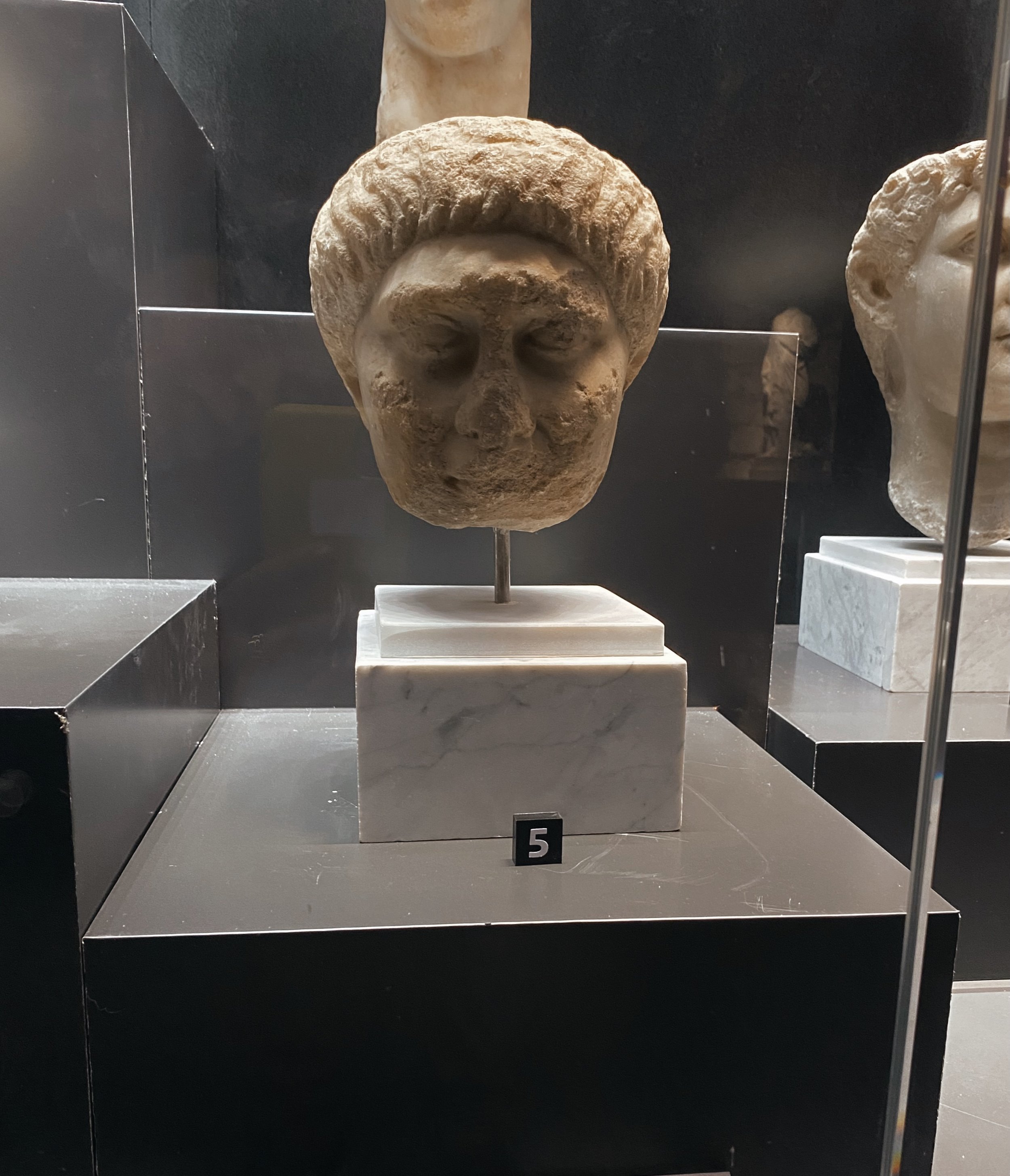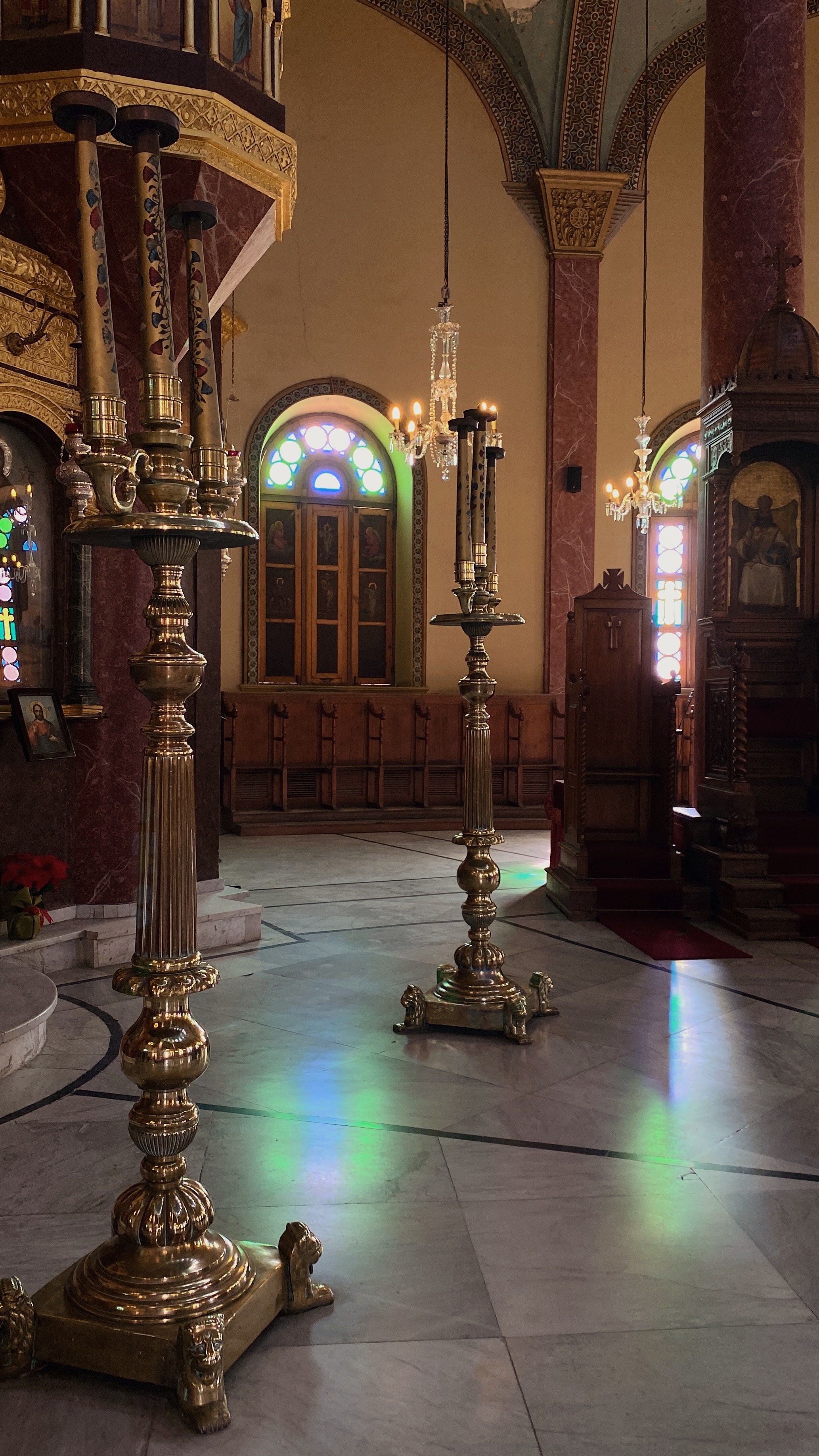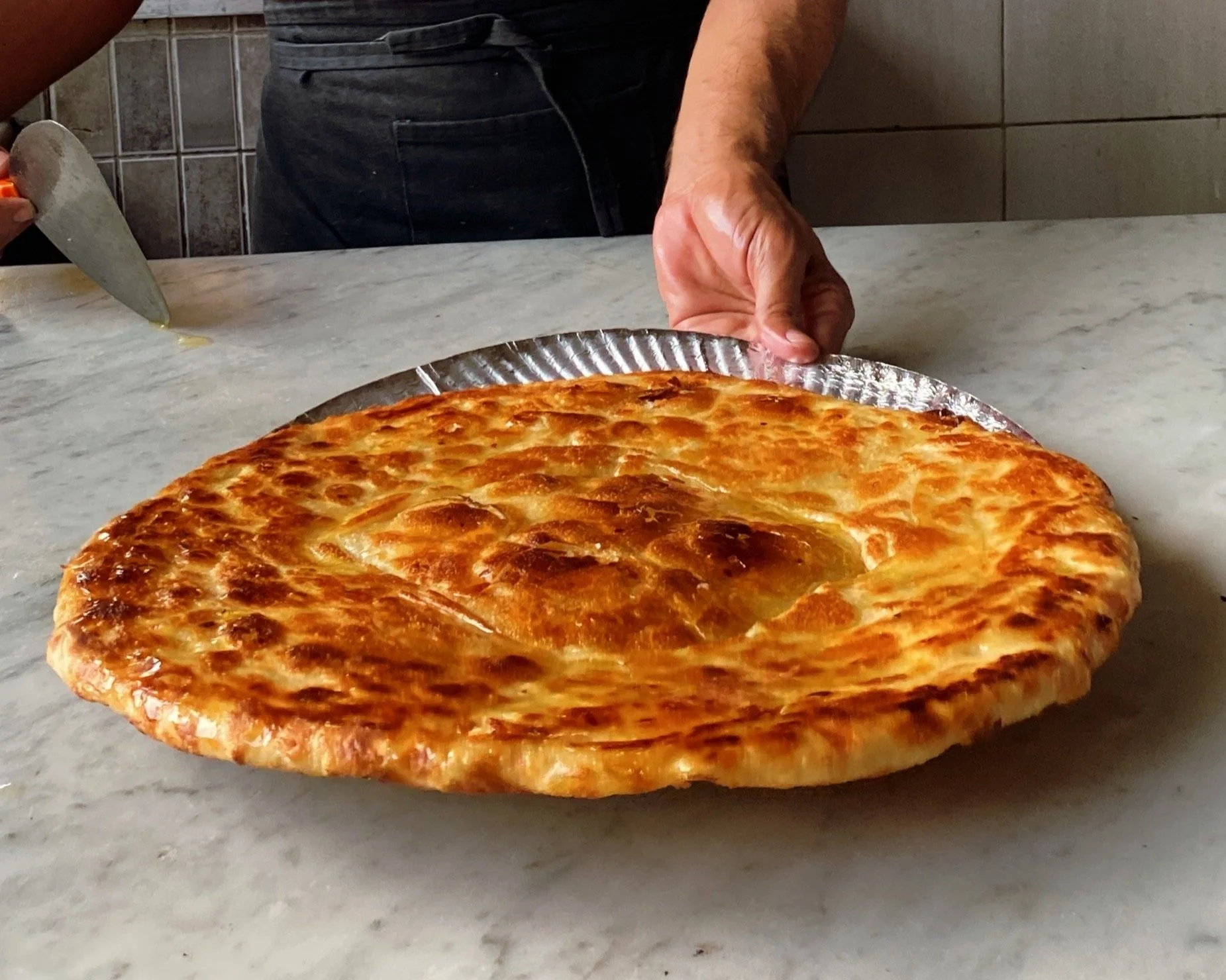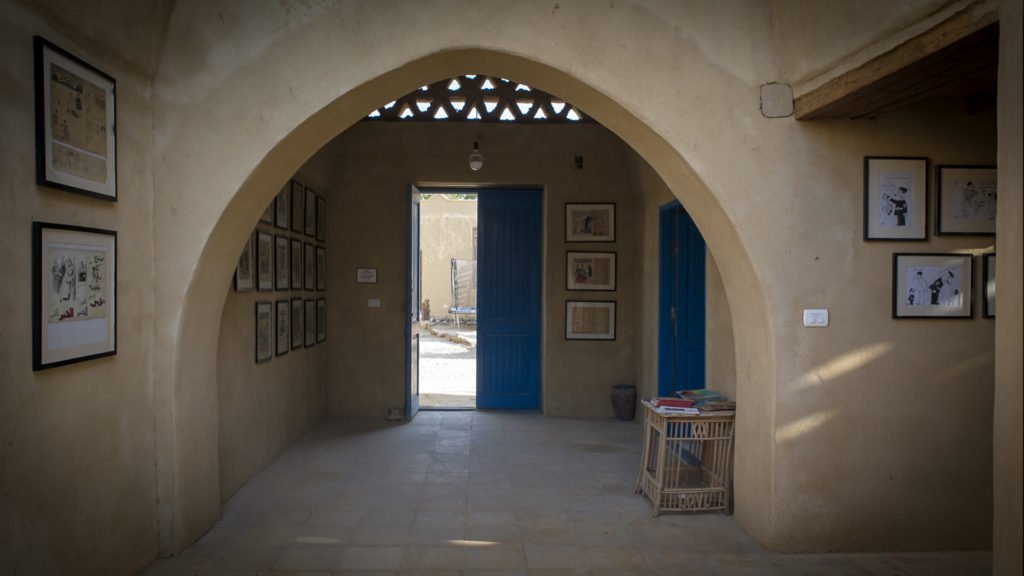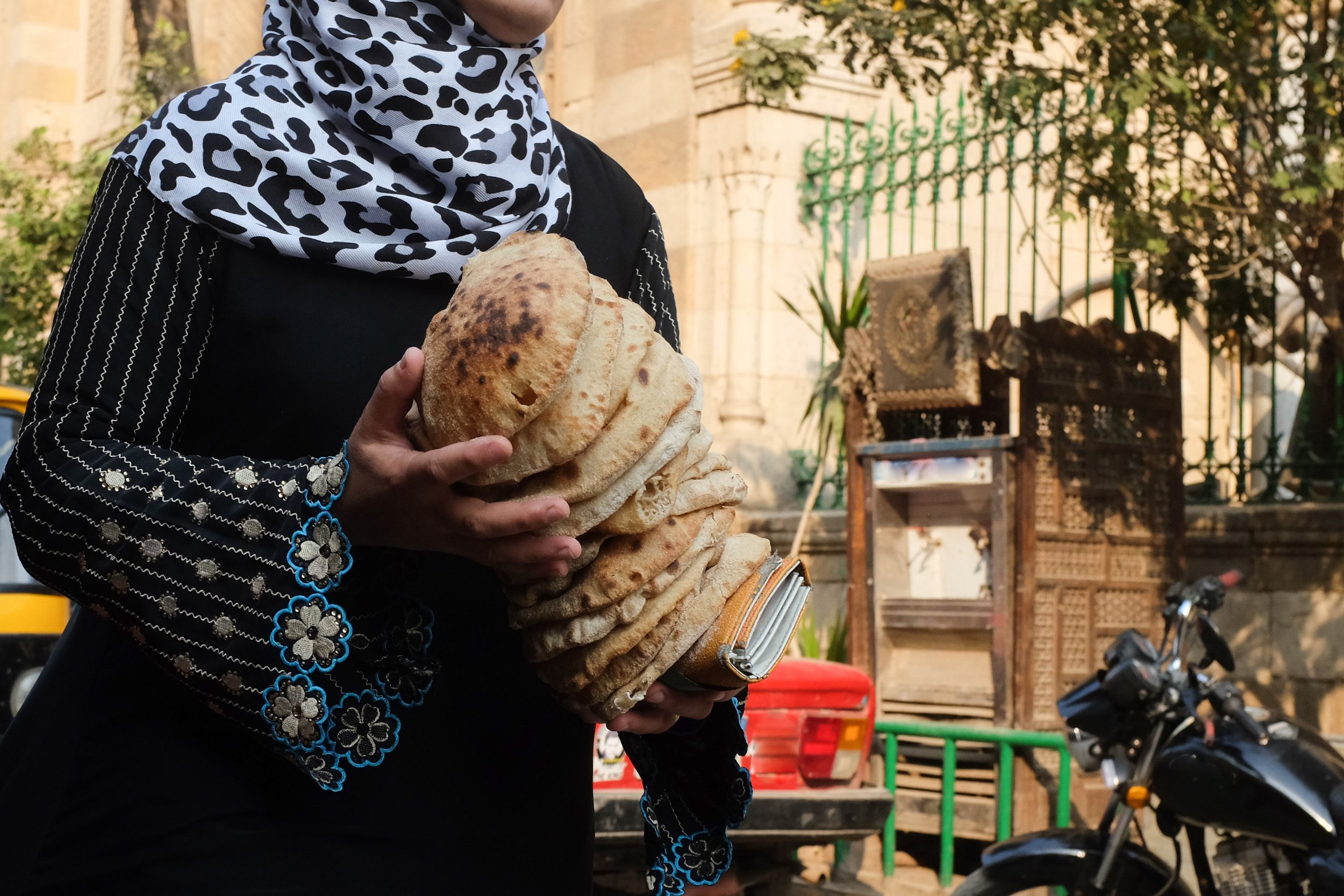
Must Visit Churches in Coptic Cairo
Cairo is a city that encompasses almost all of human history, and one of its less popular and sought-after neighbourhoods is Mar Gergis.
It is an important part of old Cairo, and it contains our recommendations for four churches to visit the next time you are in town.
Cairo is a city that encompasses almost all of human history.
For travelers with a short time in Cairo, it's common to miss out on some of these significant eras due to the large focus on Ancient Egyptian sights. And while the Giza Pyramids are a must-see, Cairo's Coptic history shouldn’t be missed, that's why today, we want to tell you about a less sought-after Coptic Cairo and its neighborhood, Mar Girgis. Cairo's Coptic history unlocks a new dimension regardless of your religious beliefs.
The neighbourhood's street sign
To learn about the fascinating history of this ancient neighborhood, we spoke with Asmaa Khattab, the founder of Walk Like an Egyptian. This tour company has been offering incredible experiences around Egypt since 2015. They offer both private and group tours of everything from the Giza Pyramids to more off-the-beaten-track sights like City of the Dead. If you’re looking for a professional team of guides in Egypt, here’s your opportunity to support a fantastic, local, female-owned business!
We’re grateful to Asmaa for her expert knowledge on this unique part of Cairo. Without further ado, here’s an intro to Coptic Cairo’s must-visit spots!
the religious complex
On the East bank of the Nile in Cairo, not far from the (new) National Museum of Egyptian Civilization is one of Cairo’s oldest neighborhoods. The greater area is known as Coptic Cairo, but it’s the Mar Girgis neighborhood, that houses what locals know as “Mogamaa Al Diyanat/Adyan” - which translates to The Religious Complex. The three religions referred to here are Islam, Christianity and Judaism. This is because this complex includes Amr Ibn al-As mosque, churches, a synagogue, and more in its vicinity!
Historically, this part of town wasn’t just significant throughout Ancient Egypt, splitting Lower and Middle Egypt, it was also where the Roman Emperor Trajan built the Babylon Fortress during the 1st century AD.
Emperor Trajan Bust at The Graeco Roman Museum in Alexandria
During the Arab conquest of Egypt, the Byzantine fortress held out for about seven months before falling in December 640 to the Arab general Amr ibn al-As
Following the Arab victory in Egypt, General Amr ibn al-As founded Fustat near Babylon, which became Egypt's first Islamic capital. The decision to repurpose the Roman fortress was motivated by its advantageous location along the Nile River and proximity to trade routes.
Fustat quickly grew into a thriving city, serving as the administrative, economic, and cultural hub for the newly conquered territory. Fustat thrived and expanded over the centuries, leaving traces of its diverse heritage as well as the cultural blend that defined Islamic Egypt.
The Religious Complex is an important part of Historic Cairo, and it contains our recommendations for four churches to visit the next time you are in town.
1- The Hanging Church
The Hanging Church, also known as Saint Virgin Mary's Coptic Orthodox Church, is located in the Coptic Cairo neighborhood (Old Cairo), near the famous Babylon Fortress and the Coptic Museum.
The church is one of the oldest Coptic Christian churches in Egypt, with its origins dating back to the 3rd century AD. The current structure is from the 7th century to the 18th century. The name "Hanging Church" is derived from its location above the gatehouse of the Babylon Fortress.
The Hanging Church is dedicated to the Virgin Mary. It is said to house important relics, including 110 icons. Formerly serving as the official residence of the Coptic Pope starting in the 11th century, the Hanging Church has been a focal point for Coptic Christians.
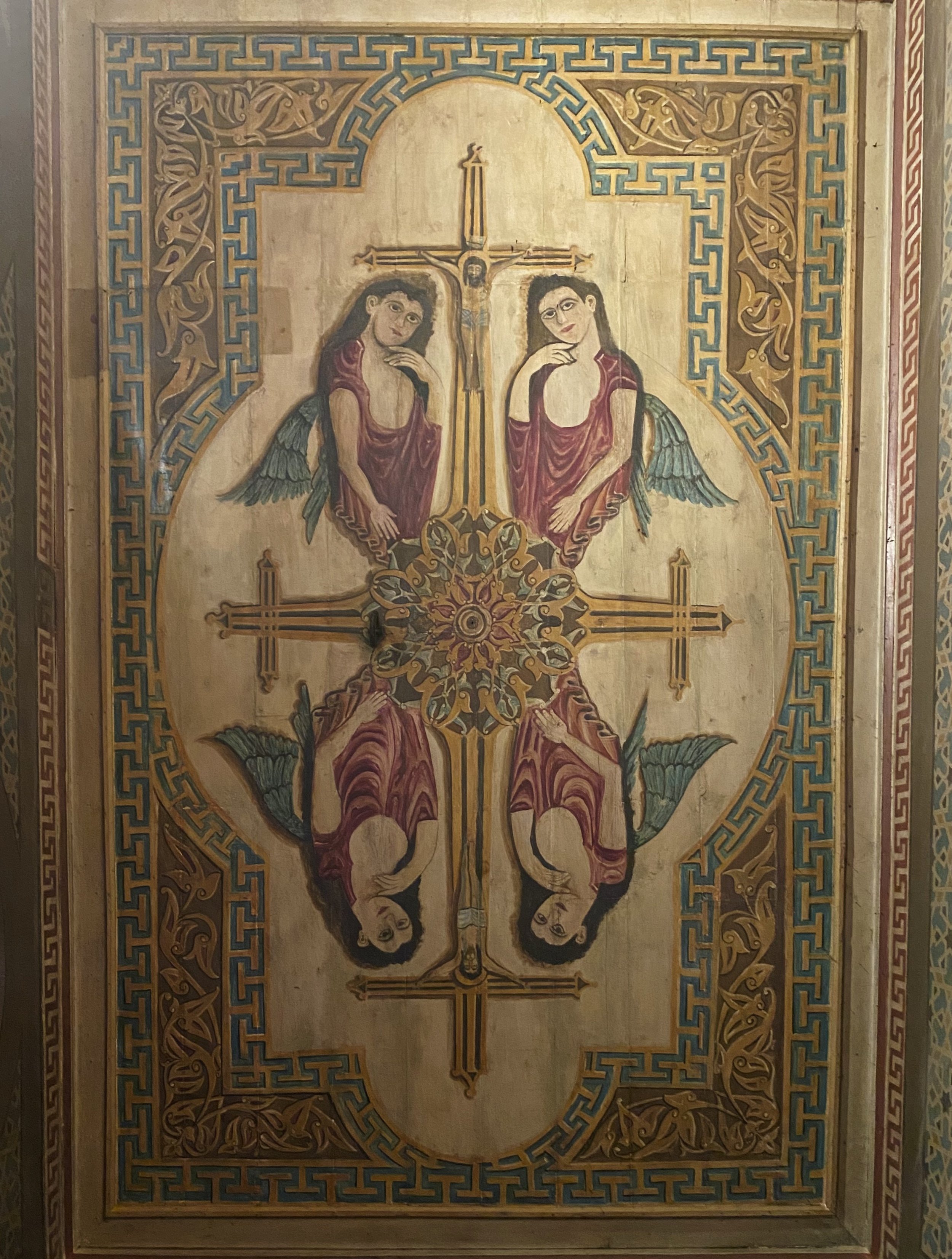
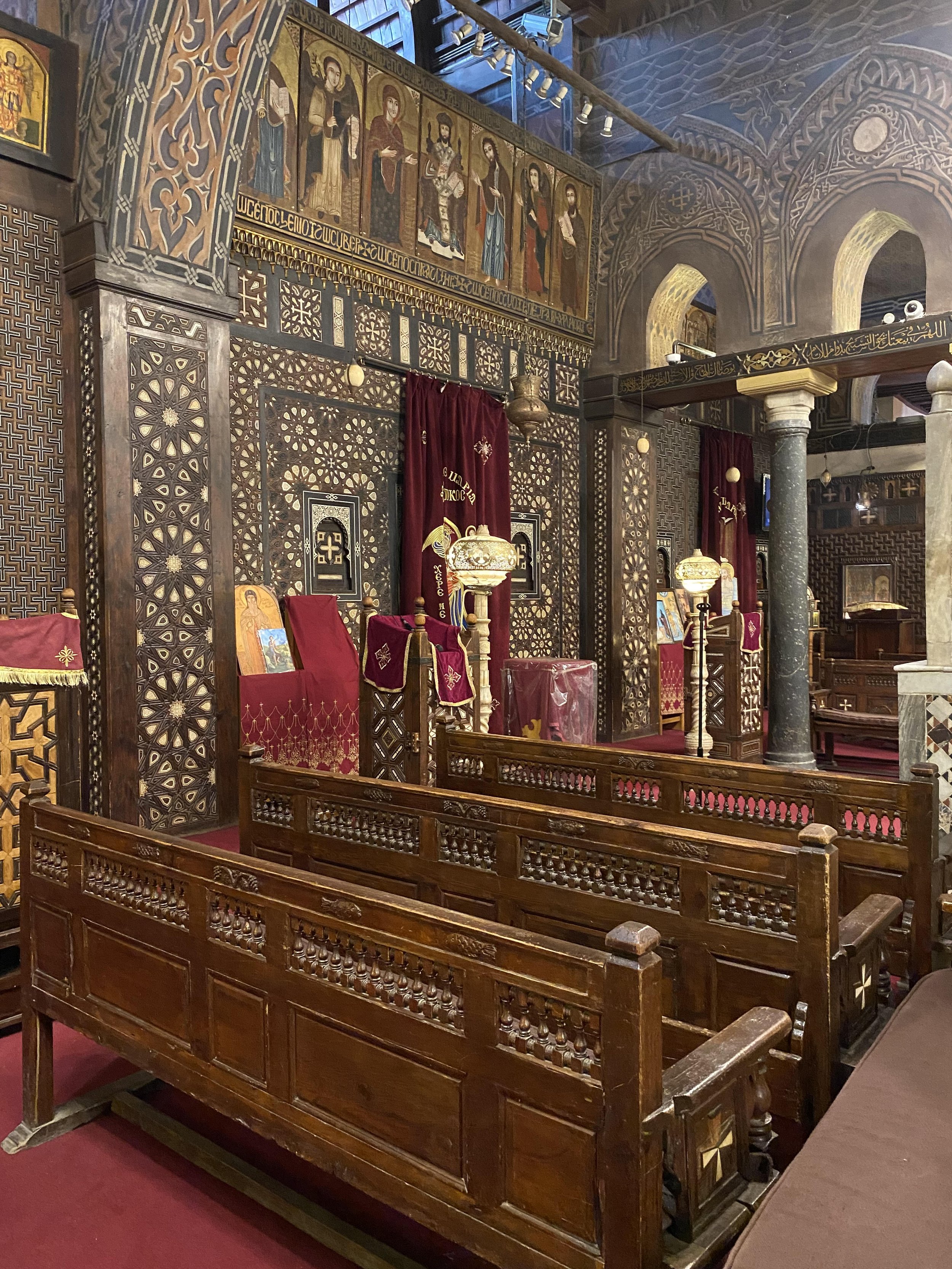
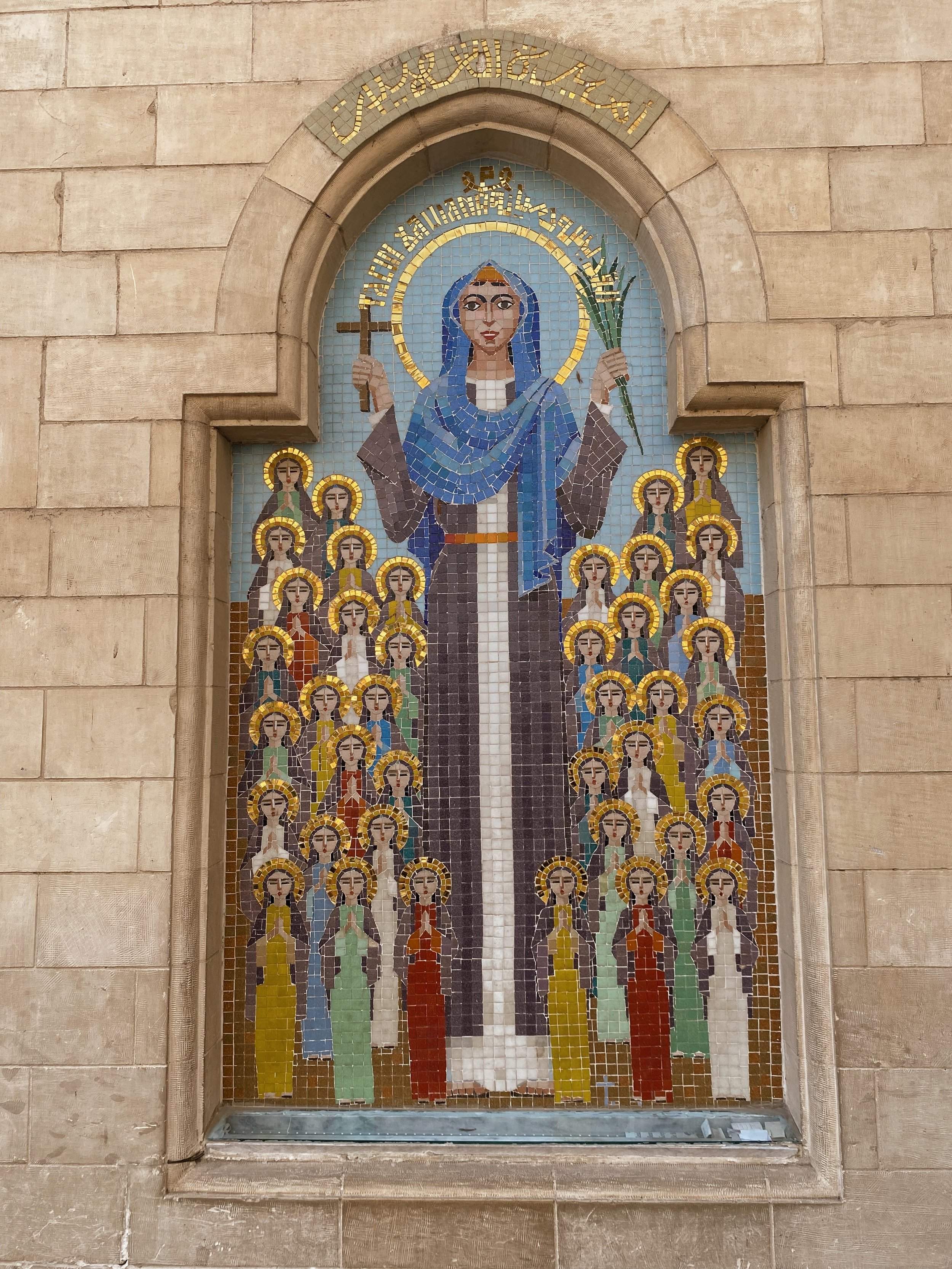
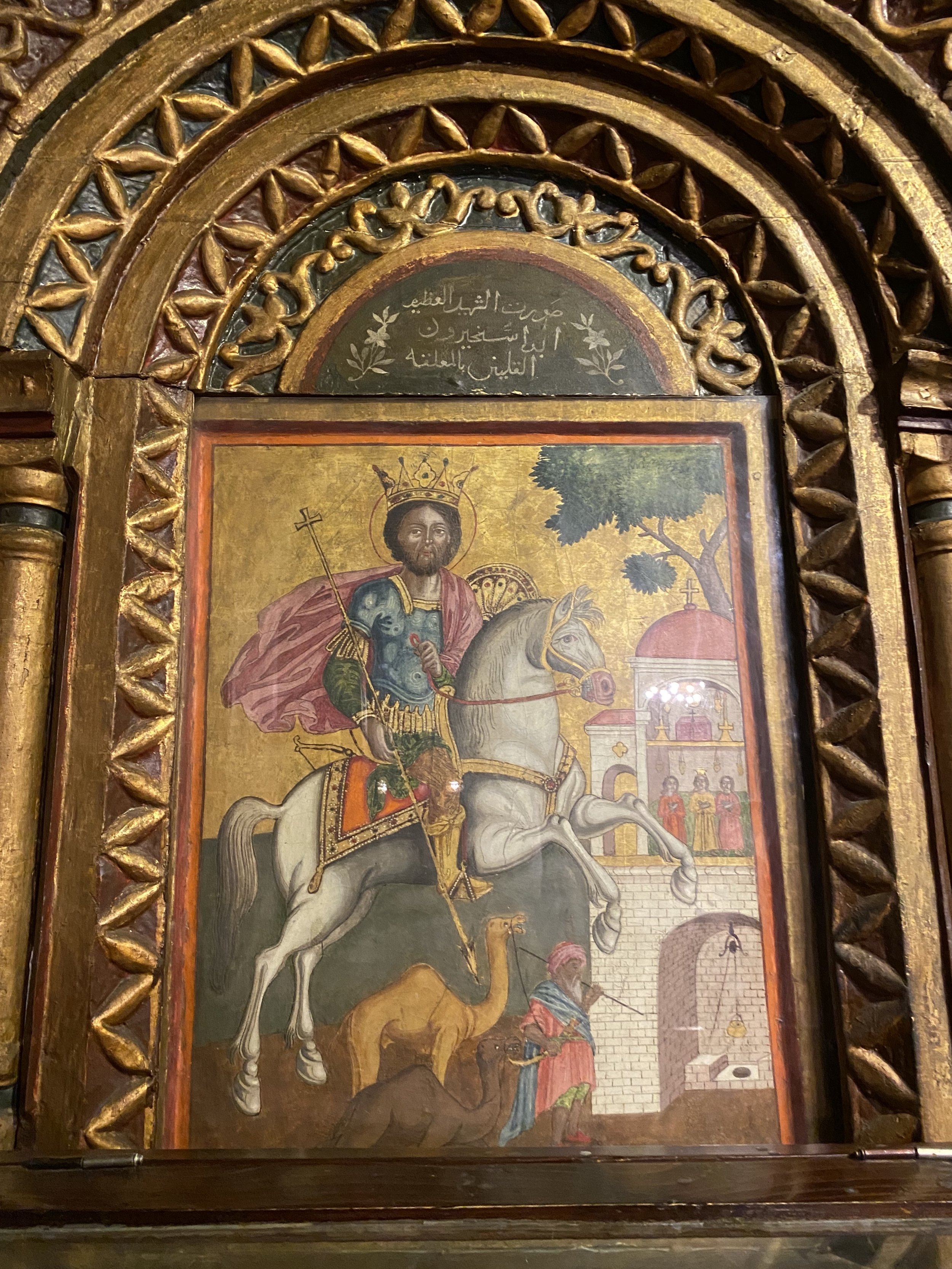
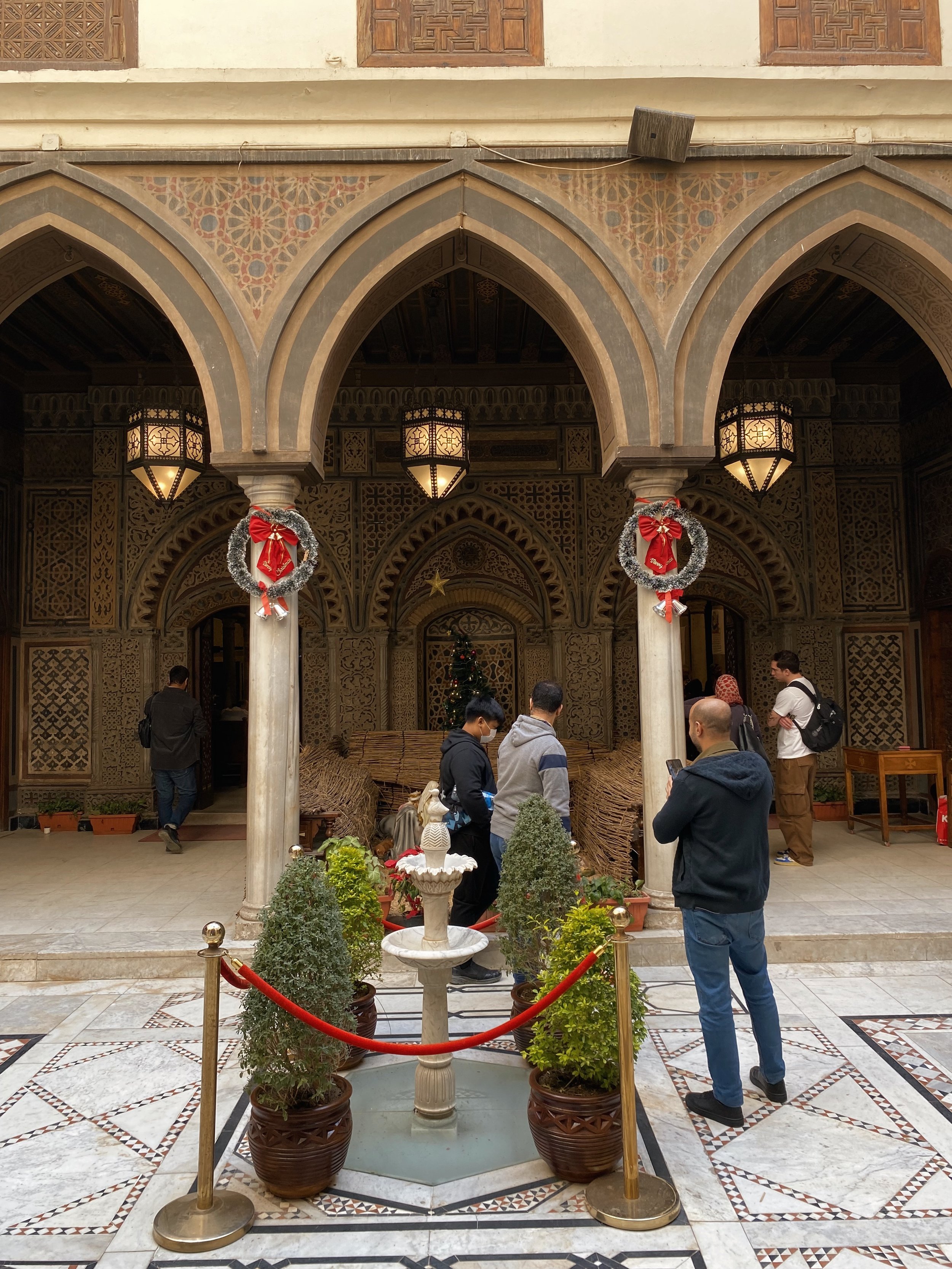
The legend surrounding the Hanging Church is intertwined with the miraculous story of the Mokattam mountain moving. This tale is based on the advice of Saint Simon the Tanner and the faith of Coptic Pope Abraham of Alexandria.
Caliph al-Muizz organized a religious debate where the patriarch Abraham, also known as Pope Abraam.
Abraham won the debate, leading Al-Muizz to challenge him to perform a miracle mentioned in the Gospel of Matthew. The caliph demanded the miracle be done within three days, or else the Copts would face persecution.
Abraham, guided by a vision of Mary, the mother of Jesus, found Simon the Tanner, a one-eyed man. Following Simon's instructions, Abraham and his followers went to the mountain with the caliph and soldiers. By praying and making the sign of the cross, the mountain was miraculously lifted. However, after the miracle, Simon disappeared, leaving the Pope searching for him in vain.
The Mokattam mountain miracle highlights the spiritual aura that surrounds this ancient church and you can find a mosaic capturing this very legend in the Hanging Church today.
You can also visit Saint Simon The Tanner Church in Mokattam which is a 20-minute car ride from The Religious Complex.
2- The Church of St Sergius & Bacchus
Known as Abu Serga, The Church of St. Sergius and Bacchus is believed to have been built in the 4th or 5th century on the site where the Holy Family, according to tradition, rested for three months during their flight into Egypt.
The church is dedicated to Saints Sergius and Bacchus, who were early Christian martyrs. They were officers in the Roman army and became known as Christian soldiers.
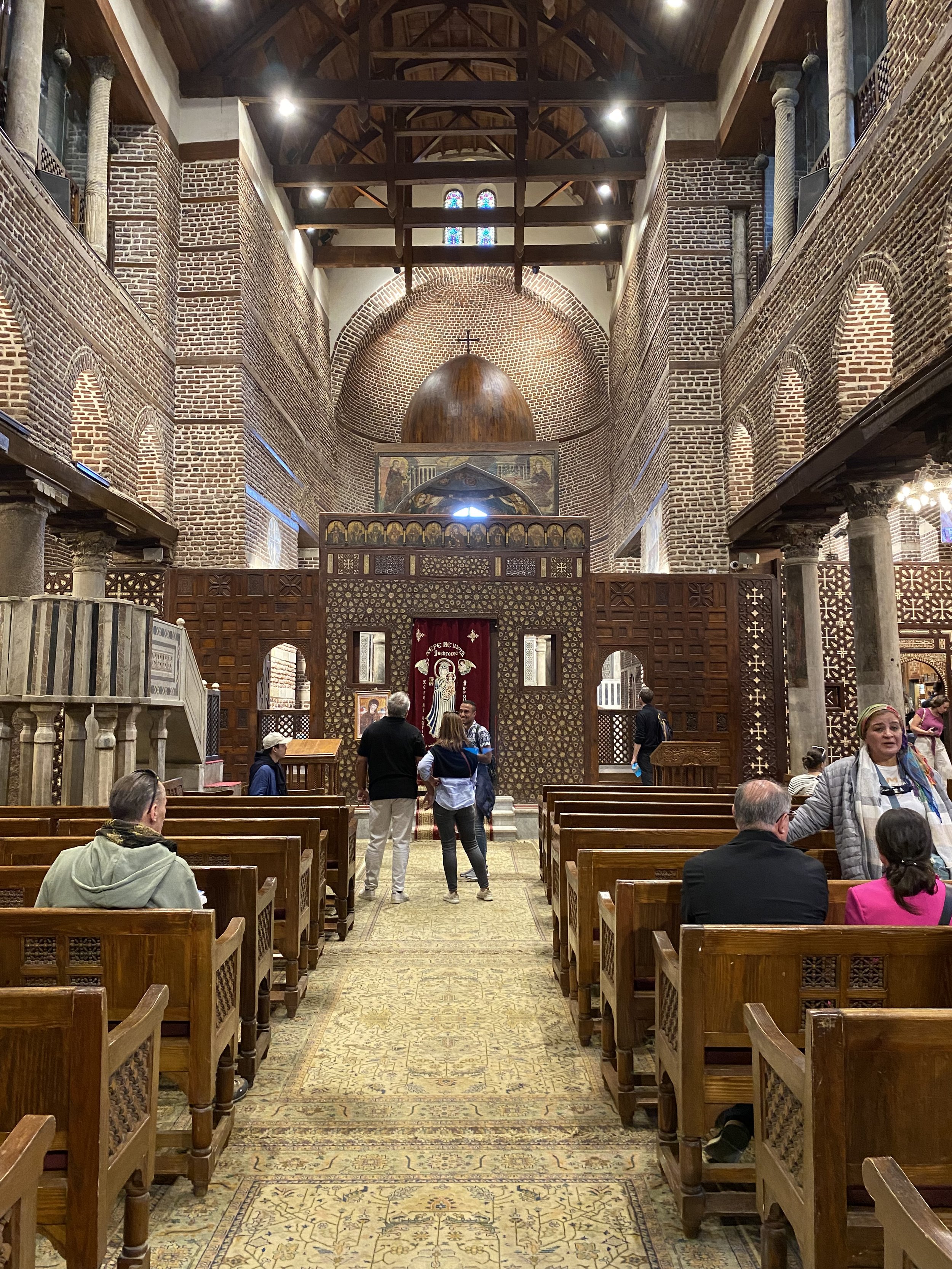
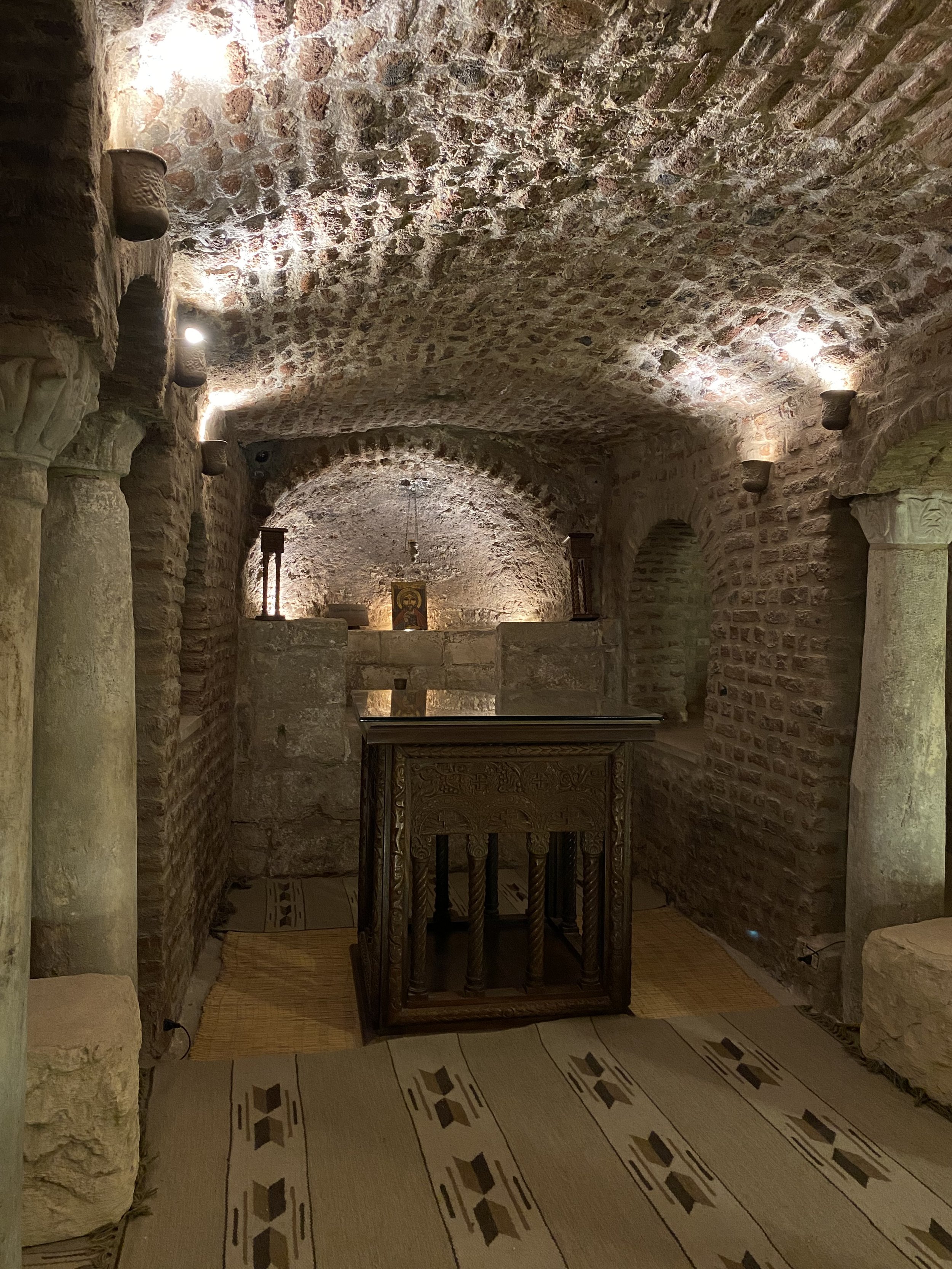
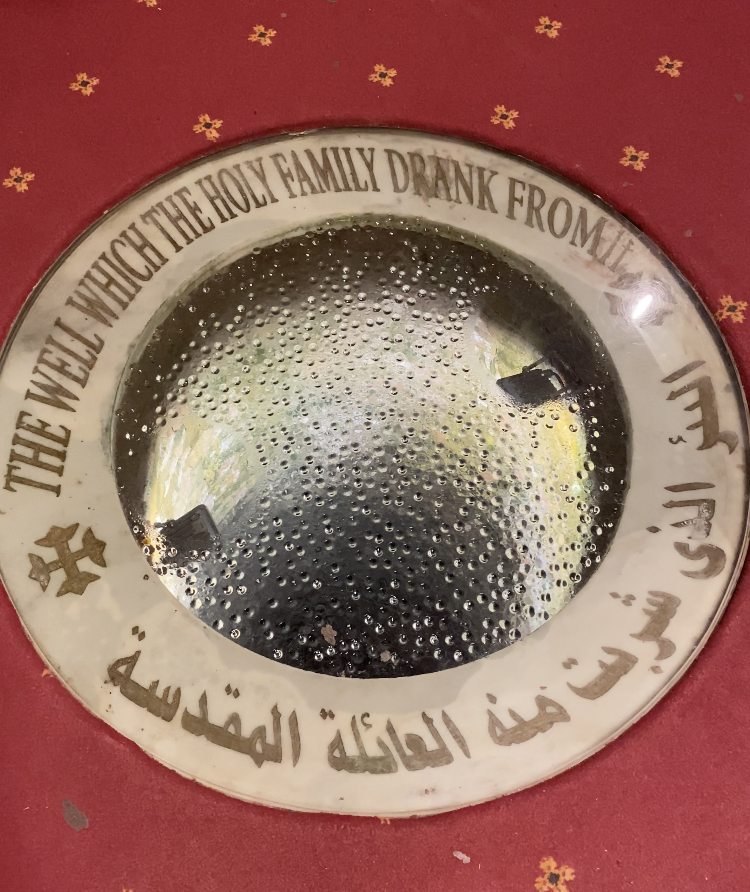
It exhibits a mix of architectural styles, including Coptic, Byzantine, and Arabic influences.
The church is considered a holy site for Coptic Christians due to its association with the Holy Family's journey to Egypt.
Legend has it that a well inside the church courtyard miraculously provided water during times of drought, it’s also said that this is the same well which the Holy family drank from.
Pilgrims and visitors often view this well as a symbol of divine intervention.
3- The Greek Orthodox Monastery & Church of St George
St George (Mar Girgis) is one of the region’s most popular Christian saints. A Palestinian conscript in the Roman army. He is one of the most venerated saints in both the Eastern Orthodox and Western Christian traditions. He is believed to have been born in the late 3rd century. George is often depicted as a Roman soldier and officer in the Roman army. According to tradition, he served under Emperor Diocletian.
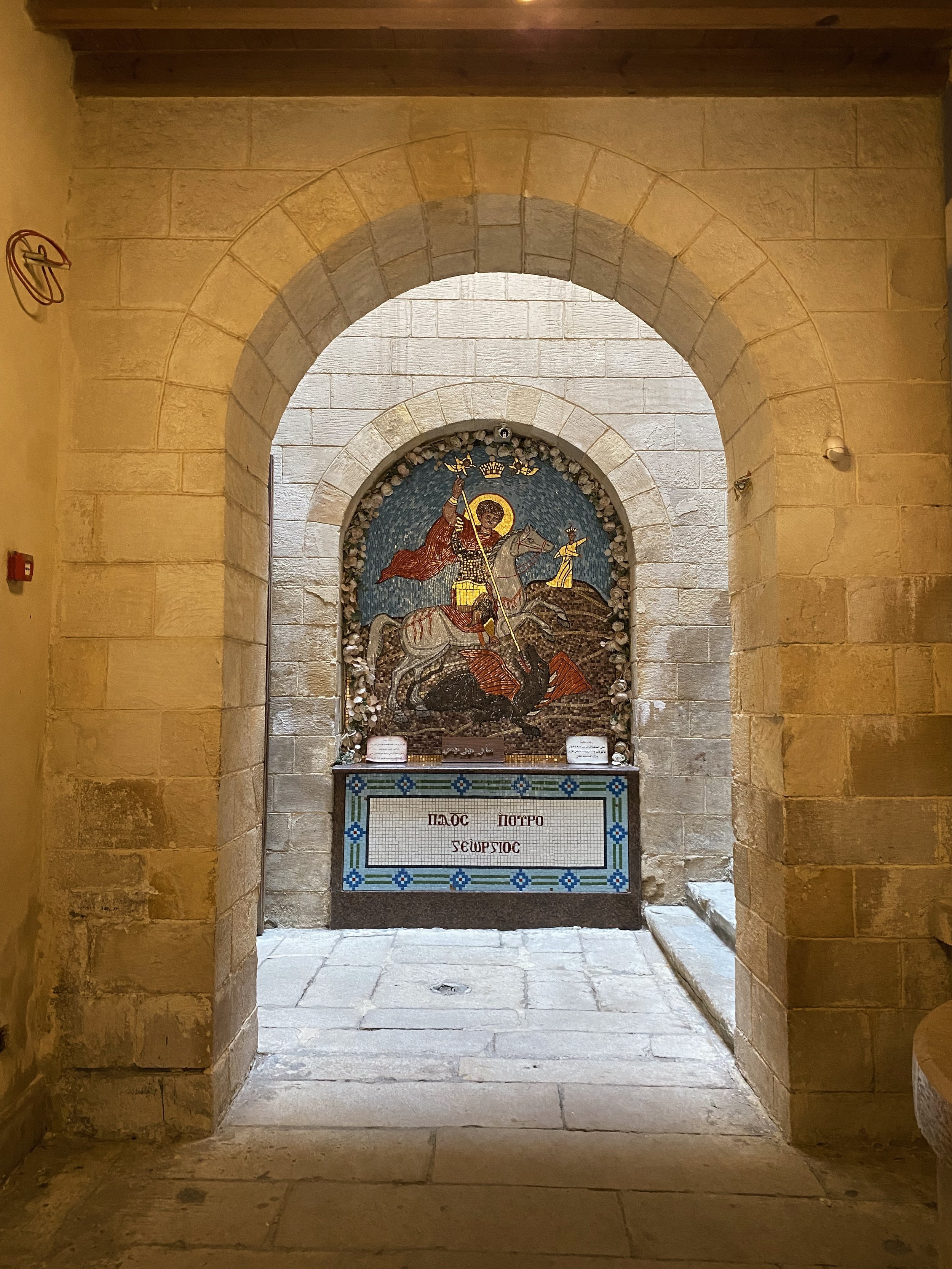
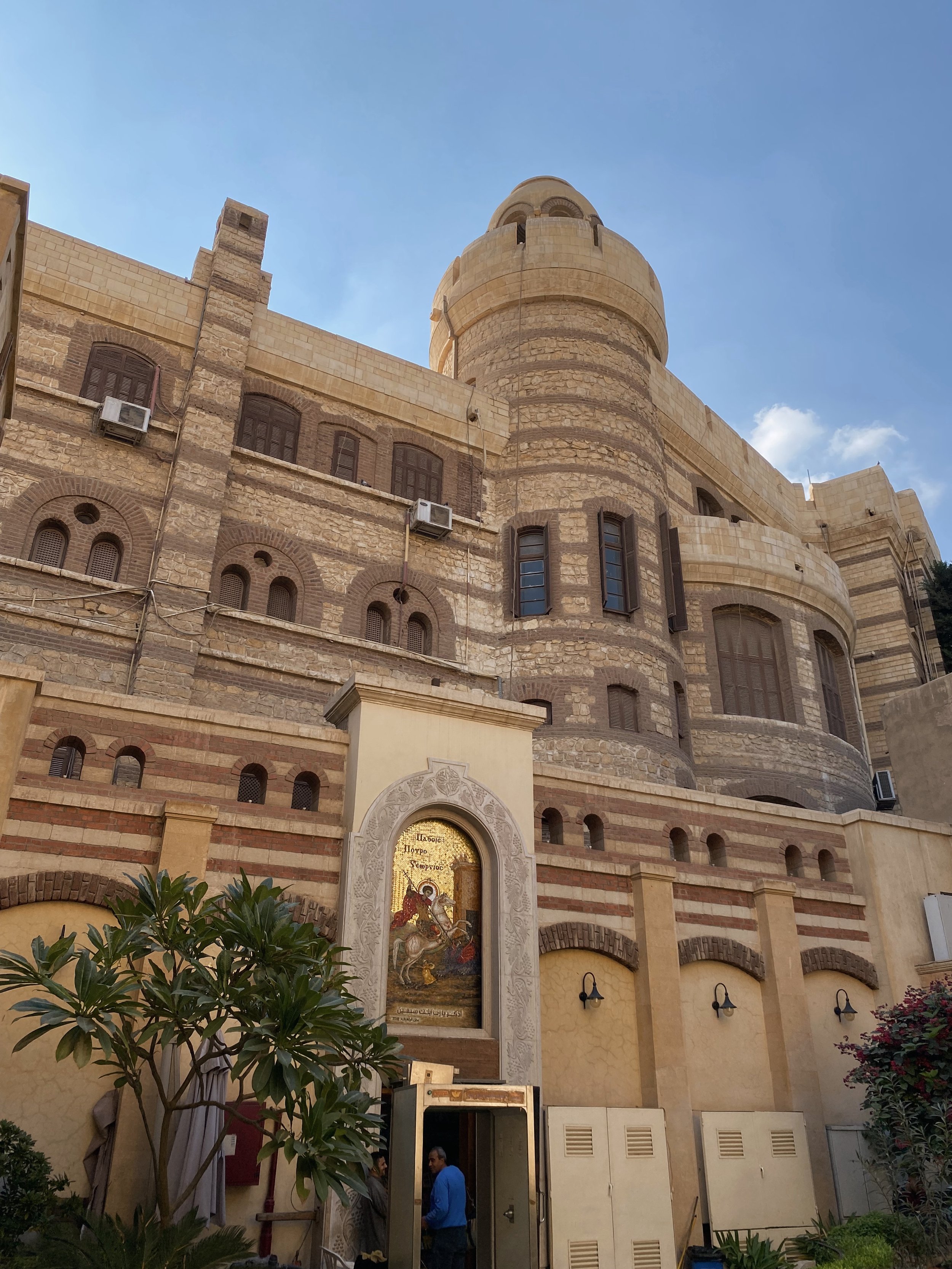


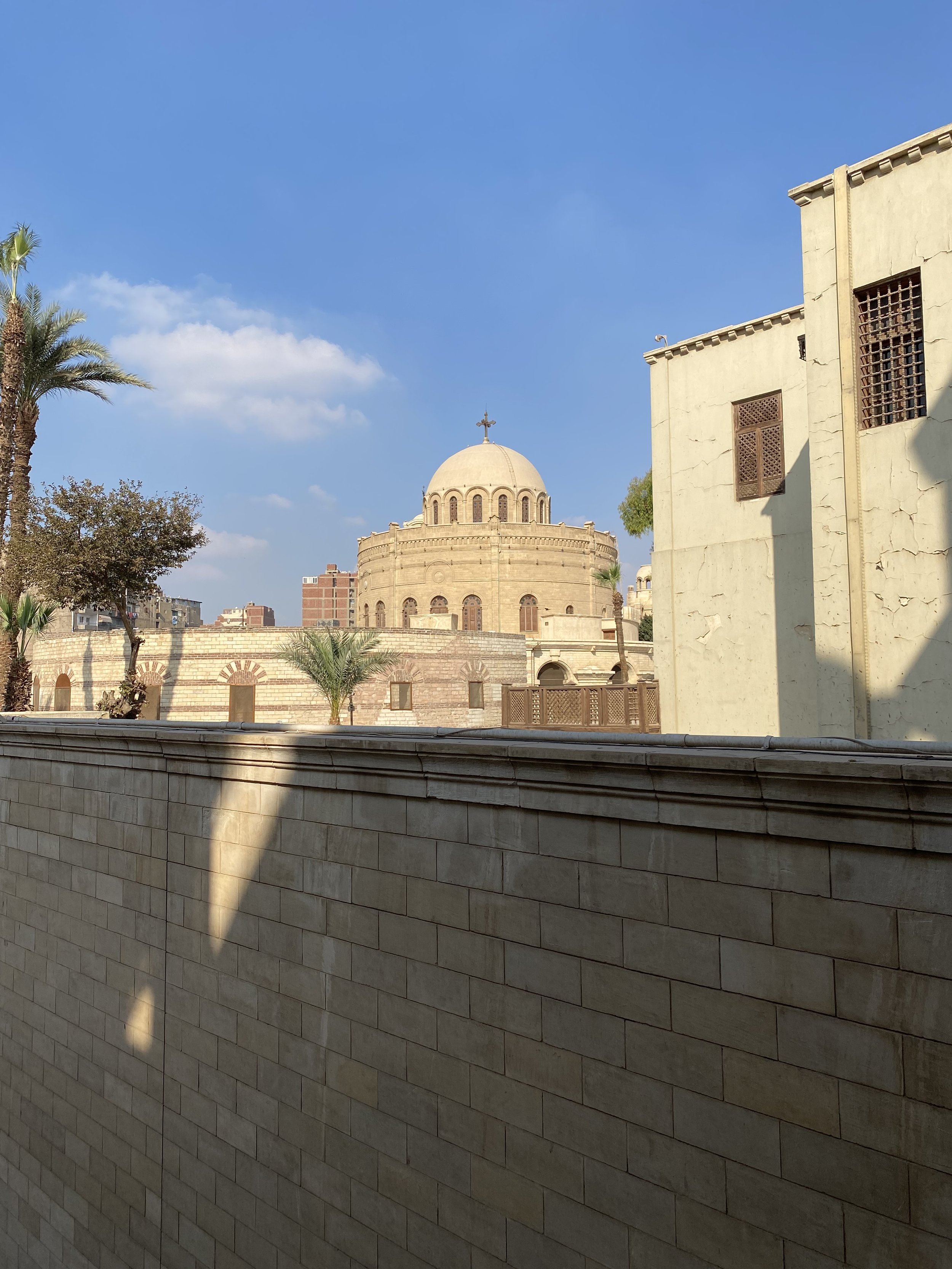
Diocletian's orders led to his imprisonment and torture. Despite facing severe trials, he remained steadfast in his Christian beliefs. The most famous legend associated with St. George is his slaying of a dragon. According to the legend, a dragon terrorized a town, and to appease it, the people offered a human sacrifice. St. George intervened, slayed the dragon, and saved the town. Coptic Cairo has had a church dedicated to St. George since the 10th century or earlier, and the one we see today was built in 1909. According to tradition, the church was built on the same site where St. George was imprisoned in the Roman fortress. Remarkably, the church houses relics and tools believed to have been used in the saint's torture, which have been preserved over the centuries.
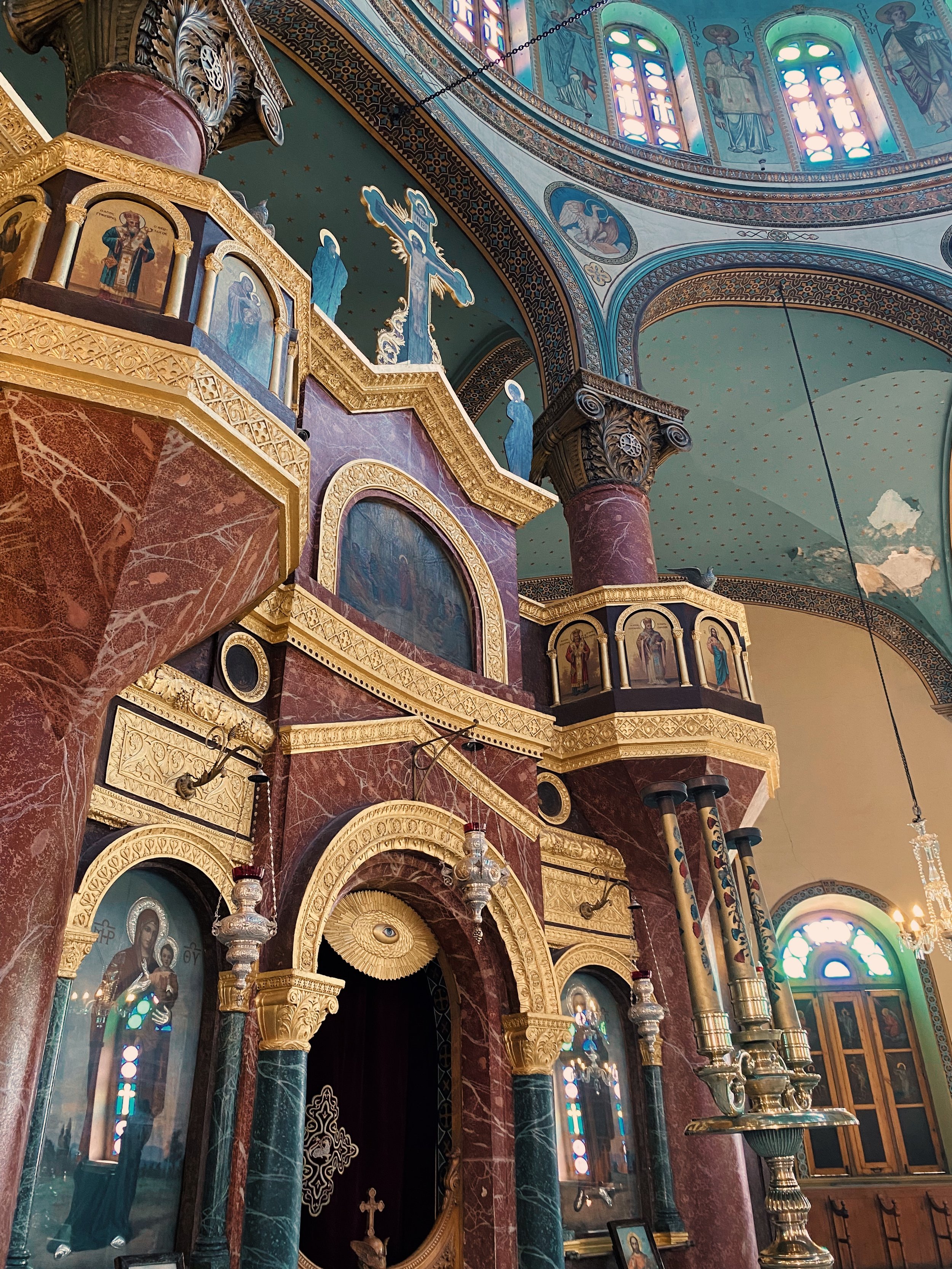
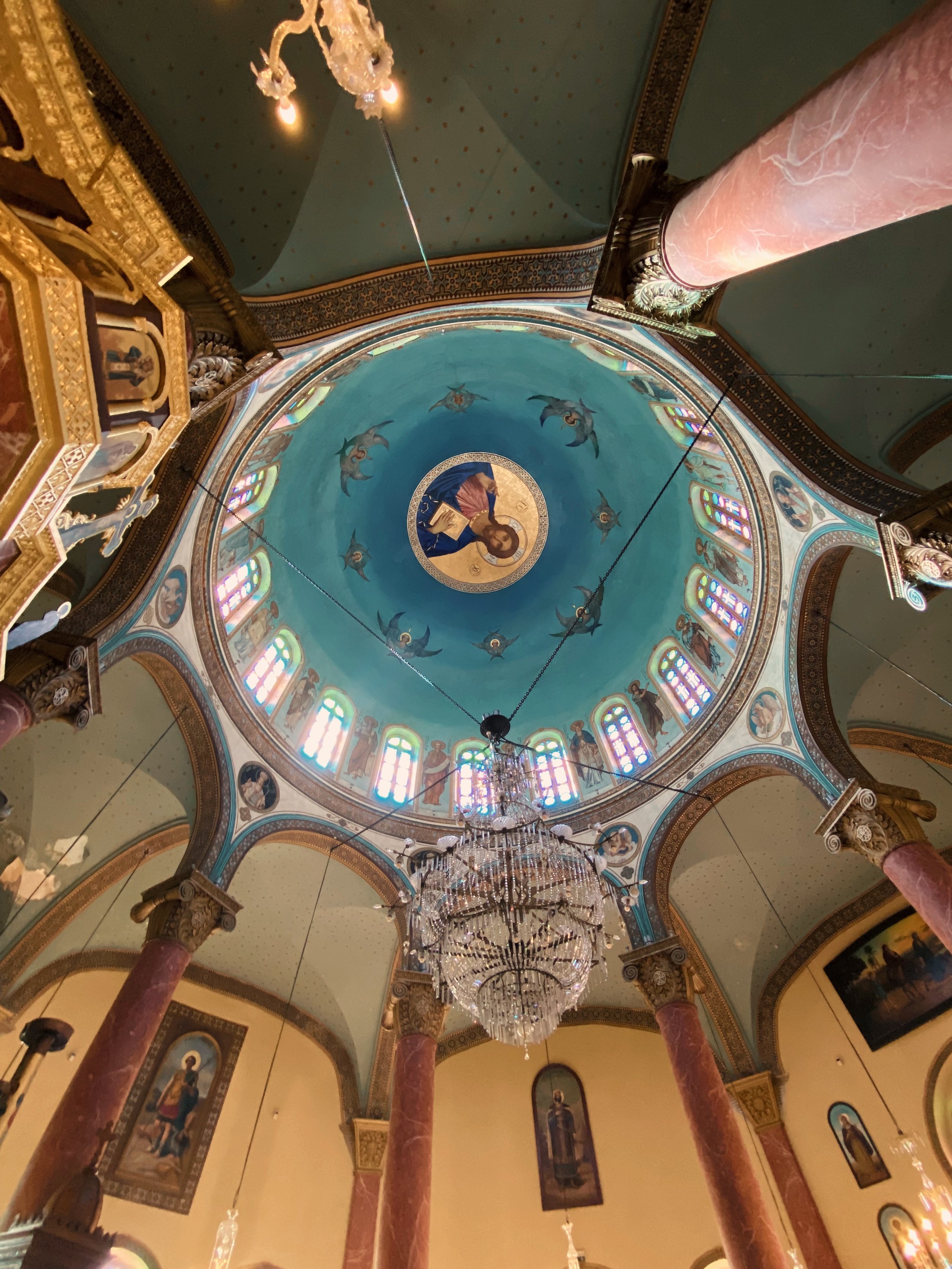
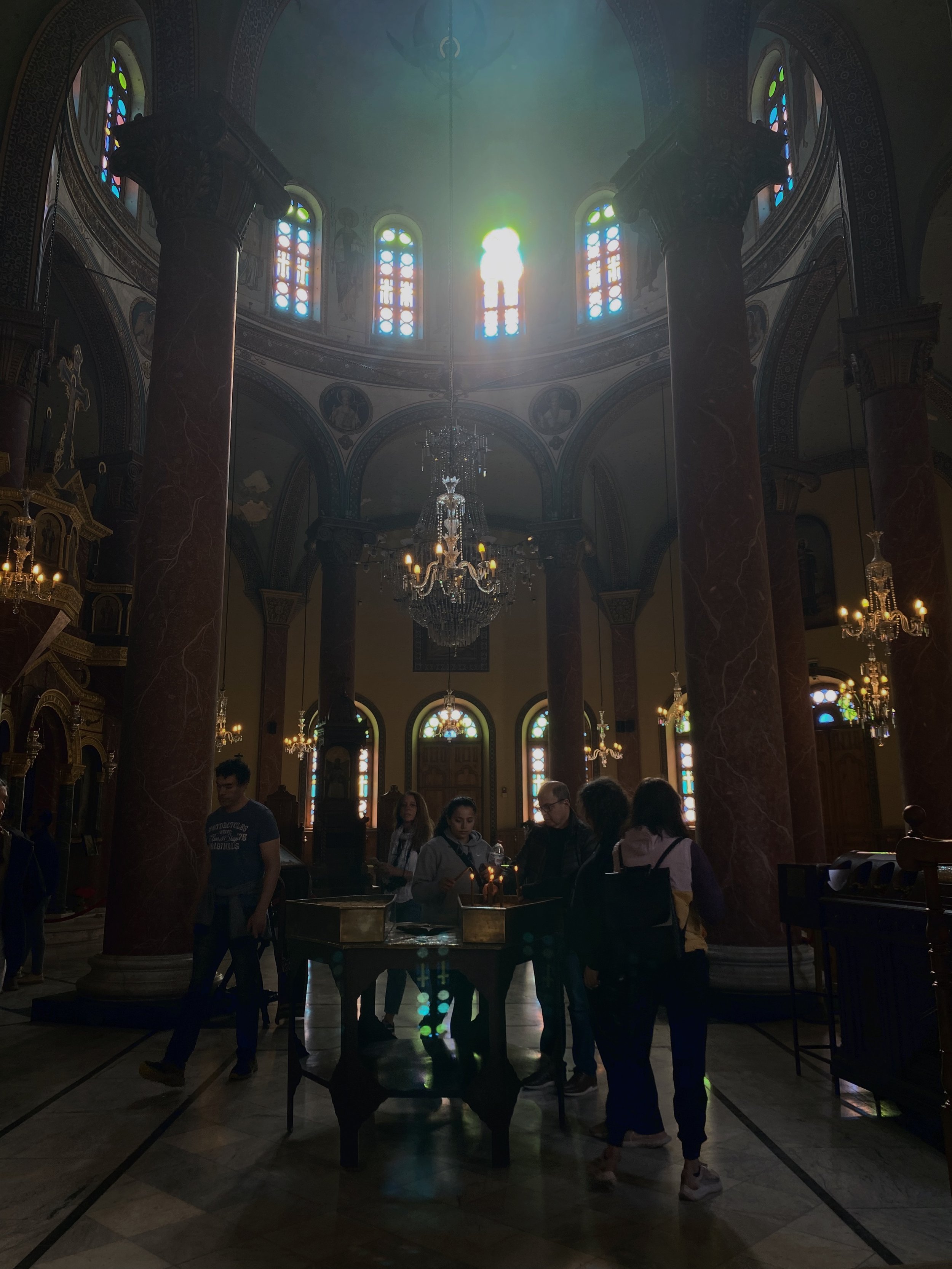
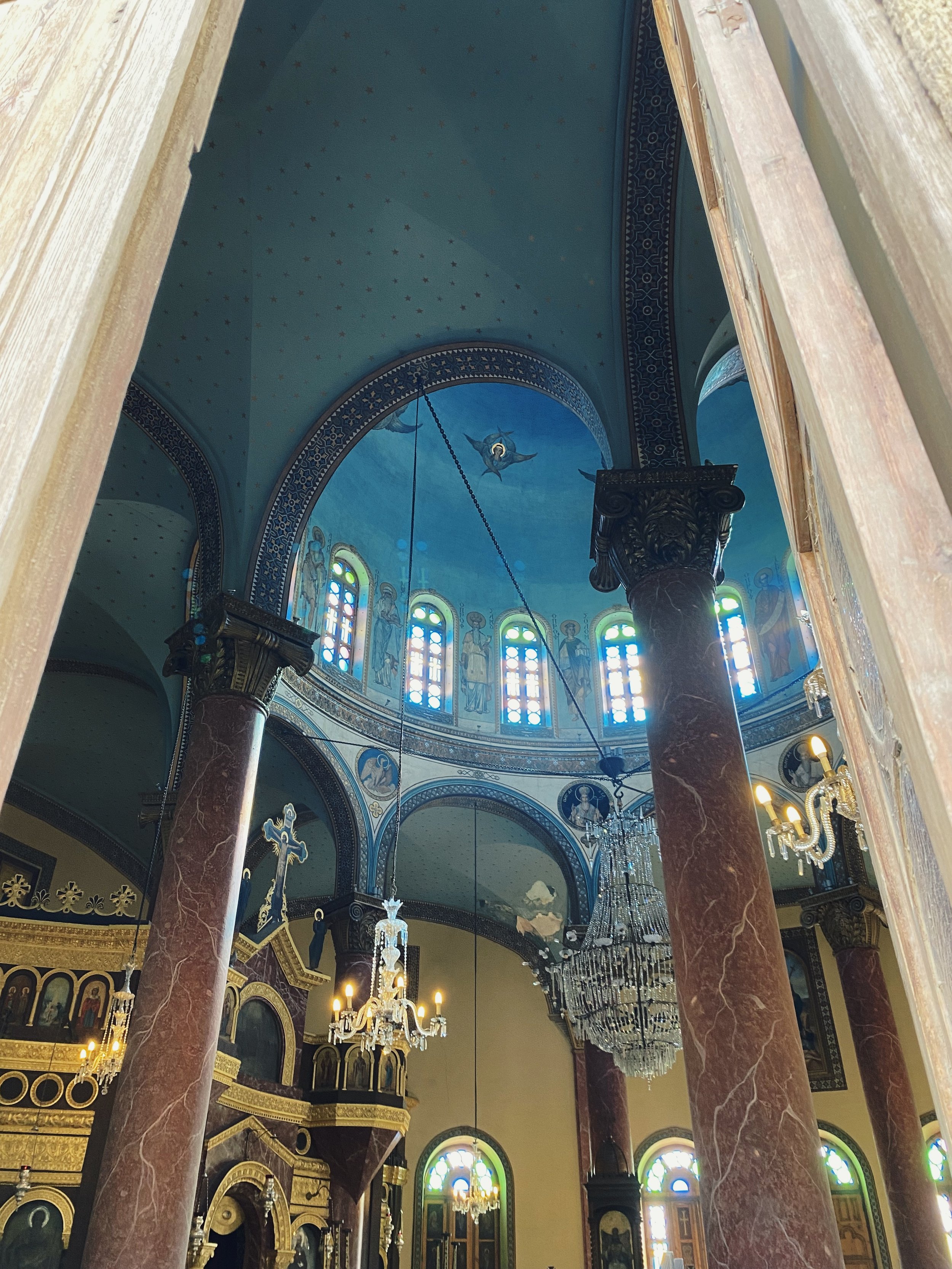
Visitors to the church leave written prayers. When these prayers are answered, devotees express their gratitude by dedicating marble plaques and leaving them with the relics.
4- The Church of Saint Barbara
The Church of St Barbara is dedicated to a martyr who was beaten to death by her father for refusing to revert back from Her Christian Faith. Her supposed relics rest in a small chapel left of the altar, along with a few other saints’ remains. The church houses some rare icons of St Barbara, the Virgin Mary, and Jesus Christ. Saint Barbara’s is considered a twin church to The Church of Abu Serga and next to it is Ben Ezra Synagogue which itself was a church.
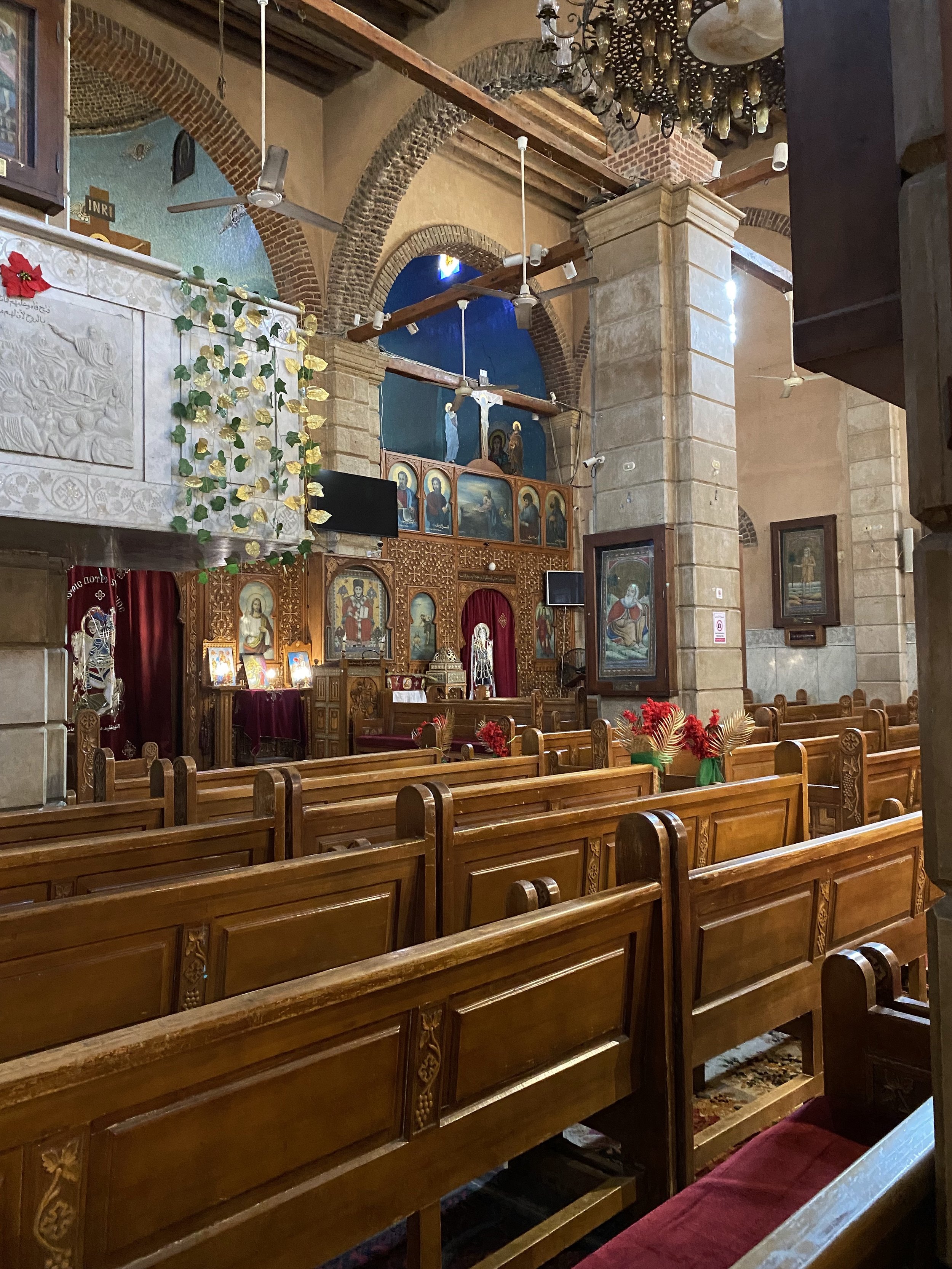
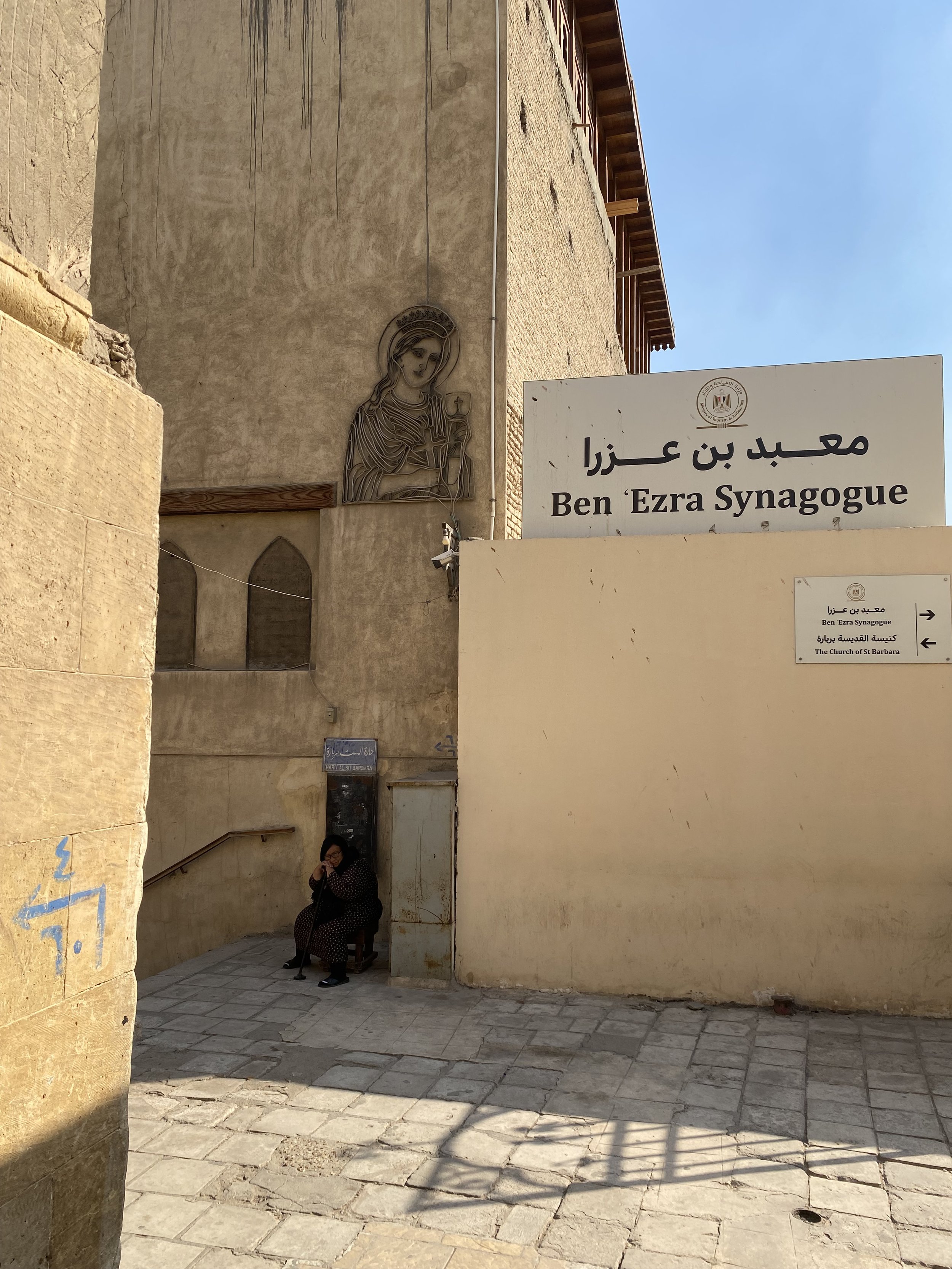
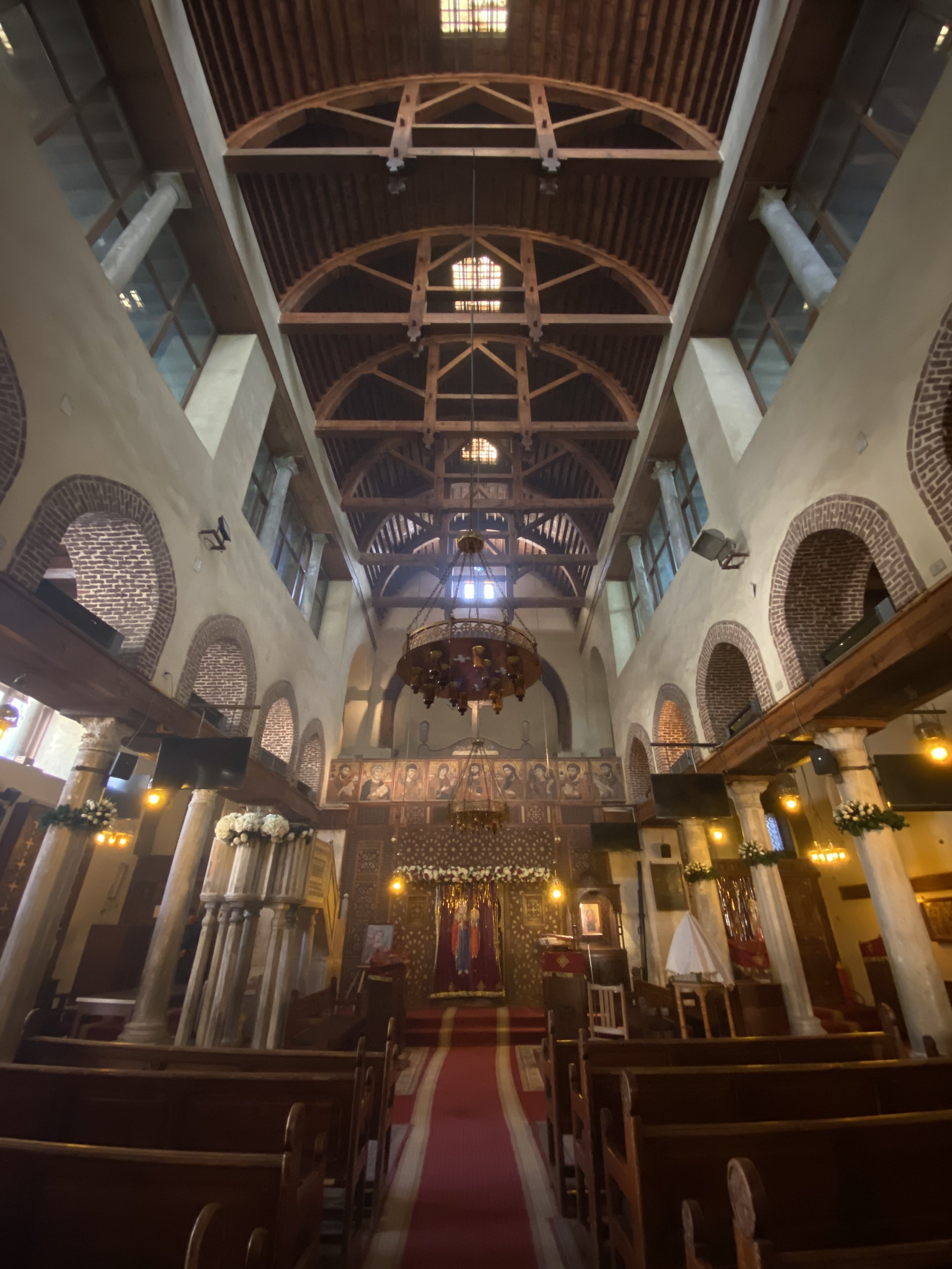
where to go next
Just beyond the complex, we come across the Amr ibn al-As Mosque, a landmark that adds another layer to the cultural area. This mosque, named after the Arab conqueror who founded the city of Fustat, serves as a poignant reminder of the region's centuries-long Islamic influence.
The essence of the Religious Complex is brought to life. It is more than just a collection of religious structures; it is a symbol of the co-existence and harmony that have defined Egypt throughout history. The convergence of different faiths within this historic enclave truly embodies the spirit of diversity and unity, making Coptic Cairo a living testament to the rich and varied religious heritage that continues to thrive in heart of Egypt's capital.
The complex is free to enter and explore, except for the Coptic Museum.
Where can we get a quick bite? Now, we won't be Bellies En-route if we don’t include our favorite restaurants to discover in the area. If you’re getting hungry after a day of exploration, Asmaa recommends Old Cairo Cafe for one of the best falafels in the area. And just outside the complex, we love eating at Haty Abu Ashraf where you can get your Kabab fix.
How do I get there? If you are in Downtown Cairo, you can take the metro directly to Mar Girgis Station!
Can you recommend a guide? Of course! We recommend Walk like an Egyptian who offer custom tours to the Religious Complex. Their expert and friendly guides will give you a brilliant experience.
Om Ali: The Mystical Dessert with a Controversial History
The idiom "we live to eat, not eat to live" is not unfamiliar in Egypt. When visiting any museum in Egypt, it is evident that the Egyptians' passion and admiration for food is a recurring motif.
The idiom "we live to eat, not eat to live" is not unfamiliar in Egypt. When visiting any museum in Egypt, it is evident that the Egyptians' passion and admiration for food is a recurring motif.
You witness murals with lavishly designed dinners and buffets to enjoy with family and friends and to commemorate big events and festivals. It's clear that a basic dessert having controversial origins isn't far-fetched.
Om Ali, which translates as Ali's Mother, has no documented recipe. It was made with ingredients found in the kitchen. Flat Egyptian pastries like Feteer or Rokak were mixed with milk, cream, or condensed milk, and topped with available nuts. It is traditionally served piping hot. Modern versions can use Puff pastry or Phyllo dough instead.
Plain Egyptian Feteer fresh out of the oven
Even though there are no historical references to the actual origin of Om Ali, these are generally held tales found in cultural conversations and culinary anecdotes that agree on the main plot lines but not some of the details. The stories have two things in common: women heroines and Om Ali.
The first stop tells the tale of Shajar Al Durr during the beginning of the Mamluk Dynasty. The Mamluk Dynasty was an Islamic medieval dynasty that ruled from the 13th to the 16th centuries. Originally Asian slave soldiers, the Mamluks rose to power in the Islamic world and established a dynasty with a strong presence in Egypt and parts of the Middle East.
The Mamluk Sultanate region of control.
Source
The Mamluks rose to prominence in Egypt during the Ayyubid period. In 1250, Mamluk commanders, led by Ezz El Din Aybak under Shajar Al Durr, took control and formed the Mamluk Sultanate. This ended the Ayyubid rule.
Shajar Al Durr being serviced by the palace staff
Source
Shajar Al Durr whose name translates to the trees of pearls, was the only woman to rule Egypt alone during the Islamic period, and it was Shajar Al Durr, not Cleopatra, who was the last woman to reign on the Egyptian throne.
After Sultan Salih Ayyub died, the kingdom was under siege by the Crusaders, so Shajar Al Durr covered the Sultan's death, declared him critically ill, and took over as de facto ruler, crushing the Crusaders with an iron fist.
“It was Shajar Al Durr, not Cleopatra, who was the last woman to reign on the Egyptian throne.”
Shajar Al Durr wanted to stay in power but faced resistance and threats of a revolt due to being a woman ruler in an Islamic Dynasty, after eighty days of her reign, she was forced to marry Ezz El Din Aybak, a commander in the Mamluk’s Elite Military under the one condition of divorcing his first wife.
Aybak was the figurehead of the new Mamluk dynasty yet the true authority remained with Shajar Al Durr. He grew tired of the minor role he played and tried to extend his reach as a ruler by taking a new bride, the princess of Mosul. Shajar Al Durr found out his plot and arranged his assassination to remain in power, but there is no solid proof that she ordered his murder.
After Aybak was assassinated, Shajar Al Durr lost her supporters. Al Mansur Ali, Aybak’s first wife's son, then took power with the aid of the Mamluks, who had turned against Shajar Al Durr.
Gustave Dore’s interpretation of Shajar Al Durr ascension to power.
Ali delivered Shajar Al Durr to his mother to decide her fate. Om Ali, Aybak’s widow and first wife, planned her revenge. She had her maids beat Shajar al Durr to death with wooden shoes “Qub Qabs”. Shajar al-Durr was later buried in a tomb, not far from the Mosque of Tulun, which is a testament to Islamic funerary architecture.
WOODEN QUB QABS
Om Ali also ordered a special pudding to celebrate justice served. She came up with the dessert, later named Om Ali by mixing Feteer or Rokak, common daily items available to poor people with the not-so-common ingredients of milk, sugar, and nuts which were expensive. The dessert represents justice and concludes a tale of revenge and retribution and is enjoyed by rich and poor people alike.
Shajar Al Durr’s resting place
Another tale is based on folklore. Om Ali is believed to have once been a commoner celebrated for her charity. When a Sultan came to her town, she wanted to make something special for him. She prepared this dish with the ingredients she had on hand and shared it with neighbours. The Sultan was so taken with it that he requested the recipe and had it produced by the royal cooks, making it famous as a royal treat.
Om Ali in Egyptian traditional clay pot
We are reminded that culinary traditions can spin complex tales of strength, resiliency, and the enduring bond between food and culture as we savor the layers of Om Ali's odd past. This dessert captures the essence of Egypt's culinary and historical legacy. It's creamy and rich, with echoes of the past in every bite.
Would you like to get your hands on our recommendations for where to try Om Ali during your visit to Cairo? Or better yet, join our class to learn how to make Om Ali yourself!
Enjoy 10% off with promo code : COOKOMALI
Off The Beaten Track: Cairo For Art Lovers
So you’ve visited all the historical sites and done all the touristy things? You’re looking for something a little different- something off the beaten track? Oh, and you’re an art lover? Say no more! Here are 10 interesting and underrated places to visit to get to know Cairo’s art scene.
So you’ve visited all the historical sites and done all the touristy things? You’re looking for something a little different- something off the beaten track? Oh, and you’re an art lover? Say no more! Here are 10 interesting and underrated places to visit to get to know Cairo’s art scene.
Zamalek’s Art Galleries
Safarkhan Gallery
Spend a relaxing afternoon walking around Zamalek appreciating Egyptian modern and contemporary art. This charming neighborhood houses many art galleries, some of which are quite old in and of themselves. While many of the galleries are located around Brazil st, don’t be afraid to walk around - you’ll definitely stumble across quite a few more! Galleries to look out for: Safarkhan Gallery, Dai Zamalek, Picasso Art Gallery, Zamalek Art Gallery, Art Corner, Al Masar Gallery.
Mahmoud Mokhtar is by far Egypt’s most famous sculptor as well as the leading figure of Egyptian nationalist modern art. He is known for impeccably blending Pharaonic and traditional agricultural themes. Mokhtar was a proud nationalist and stood against the British during the 1919 revolution- he was political and so was his work! “Egypt’s Renaissance”- his most famous statue sits just in front of Cairo University, to see the rest of his work, you have to visit his museum!
Mohamed Mahmoud Khalil Museum- Dokki, Cairo
Mohamed Mahmoud Khalil Museum, Abdallahelhaty, CC BY-SA 4.0
This museum was built in 1962 and was dedicated to two time Prime Minister of Egypt Mohamed Mahmoud Khalil Basha and his wife Emiline Lock. It is home to a collection of impressionist paintings acquired before 1928; displaying works from masters such as Gaugin, Monet, Renoir, Rodent, and Van Gogh.
Museum of Islamic Art- Downtown Cairo
Exhibition Hall in the Museum of Islamic Art, Prof. Mortel, CC BY 2.0
This stunning museum in downtown Cairo houses one of the largest collections of historical Islamic art in the world. The tradition of Islamic art is different to Western art. It's less about large paintings, and more about decorative arts like woodwork, ceramics, calligraphy, embroidery, and weaving. So don’t expect giant rooms lined with paintings- do expect everyday objects crafted with meticulous expertise and lavishly decorated with divine inspiration.
Caricature Museum- Fayoum
Established in 2009, this is one of Egypt’s youngest museums! The Caricature Museum in Tunis Village, Fayoum, is the first of its kind in the Middle East and North Africa. It is a collection of over 500 (original and) significant satirical cartoons. They trace Egyptian political and national sentiments from the early 19th century till fairly recently. Egyptians are known in the Middle East for their unwavering sense of humour, particularly during hard times. If you’re interested how politics affects art and vice versa- this is the place for you!
Musical Arts at The Opera House- Zamalek, Cairo
Cairo Opera, Daniel Csörföly, Public domain
There are a few places that stand out when thinking of musical arts in Cairo. First of which is the Egyptian Opera house which regularly has performances worth exploring. From poetry readings, film showings, to operas and ballets, they’ve got it all! Check out their website to see what’s on and don’t be shy to give them a call for more details.
Makan Center for Culture and Arts- Downtown Cairo
Mazaher, Yasseralaamobarak, CC BY-SA 4.0,
This gem is tucked away in Downtown Cairo. It hosts many experimental and traditional music experiences that are truly one of a kind. Most notably is the Mazaher Ensemble, a musical group that performs songs from the infamous supernatural Zar rituals- (google it!). Makan is a thriving musical space that is inclusive and welcoming to all. A must see if interested in exploratory, collaborative, and fusion music.
Wekalet Al-Ghoury- historic Cairo
Tanoura Performance, Tarekheikal, CC BY-SA 4.0,
The Al Tannoura Show at Wekalet Al-Ghoury in Historical Cairo is a one of a kind experience! Several traditional dances are performed in the courtyard of a stunning medieval complex- built in 1504. You will be mesmerized by the colors and the music. Spend an whimsical evening in old Cairo and you will not be disappointed.
Excursions for those with time to spare
Tunis Village, Hatem Moushir, CC BY-SA 4.0
Located a couple of hours away from Cairo, Tunis Village in Fayoum is ideal for a day trip. This small village has developed in recent years as a pottery and ceramics hub. It is a rural area with vast farms that inspire much of the ceramics made. The small streets are lined with shops selling unique and handmade pieces, no two pieces are the same. It’s a haven for those who enjoy rustic crockery! You can even order customized pieces from the artisans if you know you’ll be back in town a few months later. Tunis Village also has a lively mural art scene! Many of the homes there are painted by local or international artists- it’s quite a sight to see!
Perception by Elseed- Mansheyet Nasser, Cairo
Zaraeeb, Ouahidb, CC BY-SA 4.0
In 2016, French Tunisian artist came to Cairo and created a spectacular piece of artwork spanning over 50 buildings- that can only be seen from a specific angle and location. This masterpiece is in Mansheyet Nasser, home to a large Coptic Christian community that collects, sorts, and sells Cairo’s garbage. The calligraphy is a quote from the 3rd century Coptic Saint Athanasius of Alexandria: “Anyone who wants to see the sunlight clearly needs to wipe his eyes first”.
Important notice: Please be aware that this neighborhood has been neglected and marginalized, and it is not a typical tourist destination. We strongly advise approaching this community with sensitivity and respect. It is also recommended to have someone who speaks Egyptian accompany you.
To find the viewing point, it's best to ask the locals for directions. However, please be aware that whether they guide you there or not depends on the willingness of the community members. Remember to always be kind, respectful, and considerate during your visit, and avoid taking photos unless you have received permission.
Bonus: We’d recommend checking Art Cairo and Art d’Egypte before your visit to see if any contemporary art exhibits are on during your time in Cairo. Their art shows are quite seasonal, but if you’re lucky enough to catch one- you won’t be disappointed.
Spice Shops & Herbal Havens: Where Flavors and Remedies Collide!
Step right into the enchanting realm of Egyptian spice and herb shops! Imagine shelves bursting with vibrant powders, the scent of aromatic incense wafting through the air, and an array of peculiar treasures displayed in countless glass jars. Welcome to the wacky, wonderful world of el-Attar, where flavors and remedies intertwine!
Step right into the enchanting realm of Egyptian spice and herb shops! Imagine shelves bursting with vibrant powders, the scent of aromatic incense wafting through the air, and an array of peculiar treasures displayed in countless glass jars. Welcome to the wacky, wonderful world of el-Attar, where flavors and remedies intertwine!
These quirky, old-timey shops can be found all over Egypt, from bustling city centers to quaint rural towns. They are not your ordinary spice shops, mind you—they are more like apothecaries. They serve as a hub for locals to explore and acquire herbs, spices, seeds, grains, oils, and more, all for the purpose of cooking as well as home remedies. Now, we know herbal remedies can be a touchy subject, but hey, our ancestors relied on them long before modern medicine came along, so there must be something to it, right?
An assortment of spices at a Attar shop.
We had the pleasure of sitting down with Ahmed Zalat, the proud owner of one of Cairo's oldest spice and herb shops. This gem has been around for over 120 years! Ahmed inherited his craft from his father, who inherited it from his father before him—a tradition that runs deep in this field. Ahmed's life has been devoted to the pursuit of healing through herbal remedies, spending countless hours studying the properties of herbs, spices, and other natural ingredients.
Ahmed Zalat, Herbalist, explains to us the ins and outs of the trade.
Ahmed shed light on the delicate nature of working with herbs. Did you know that certain materials can affect the potency of herbs? Some plants can only be ground using a marble mortar and pestle, while others demand the touch of brass. Some flowers and leaves must be harvested under the cover of darkness to avoid sunlight. Others are plucked during specific lunar phases, like the new or full moon. Each plant has its own set of rules, and mastering them requires a lifelong commitment and deep passion. While many spices are locally grown, some exotic ones that thrive in tropical climates are imported.
Egyptians have always had a profound love affair with spices. Let me share a little historical nugget with you: In the 17th century, a Western traveler visited Egypt and wrote in his memoirs how taken aback he was by how generously and enthusiastically Egyptians seasoned their food. At the time, spices were expensive and hard to come by in Europe. But in Egypt, they were cheap and plentiful- so people had at it! Egyptians simply detest blandness and believe that a well-seasoned meal is the hallmark of a skilled cook.
Ahmed Zalat’s shop near el-Azhar mosque in Historic Cairo
Ahmed Zalat didn't stop at traditional herbalism—he took it up a notch! While many Attareen (that's the plural of Attar, the term for spice sellers) prefer to carry out their trade informally through word of mouth, Ahmed is all about sharing knowledge. Alongside concocting custom herbal cures and oil blends for common ailments, he has written and printed booklets that delve into medical issues prevalent in our communities. You name it—high blood pressure, kidney stones, asthma, diabetes—his booklets cover them all. And fear not, for the instructions on how to use these remedies are included as well. Paying a visit to Ahmed Zalat's shop near el Azhar mosque is an experience like no other. Most Attar shops don't offer professionally packaged remedies or informative booklets.
Home remedies are deeply ingrained in Egyptian culture! You don't need to be a certified herbal specialist to know a few tricks of the trade. Anise tea for a good night's sleep, guava leaf tea for cough relief, cumin tea to soothe a bloated stomach—these simple solutions are the go-to requests at Attar shops. Of course, it's perfectly normal to seek remedies for specific ailments too. The shop owner will gladly recommend a suitable remedy and provide instructions on how to use it correctly. And hey, don't limit yourself to health concerns—beauty-related issues have their remedies too! Feeling the effects of dull skin or fine lines? Grab some chickpea powder! Dealing with thinning hair? Castor oil to the rescue!
Remedies, creams, and oils at Ahmed Zalat’s Attar
Hibiscus tea is like a superstar remedy in Egyptian households. It's not only super tasty and enjoyed regardless of health concerns, but it's also known to help with high blood pressure. This tea, also called sorrel or roselle, is packed with antioxidants and anti-inflammatory goodness that does wonders for your overall health. But hold on a sec! If you do a quick Google search, you'll find that while hibiscus tea can slightly lower blood pressure, it's not a substitute for medication when it comes to hypertension. So, enjoy it for its flavor and health benefits, but don't skip your prescribed meds, okay?
Which brings us to something a bit eerie but fascinating: incense burning, known as Bukhoor in Arabic. Egyptians use incense in their homes to cleanse and keep away negative energy and spirits. It's tied to the belief in the "evil eye" or envy that can harm you. To protect themselves, people spread incense smoke all around their homes. But get this—it's not just any incense. They use a special kind made with ingredients from these cool spice shops called Attar shops. One ingredient you might come across is Ain el-Afreet (eye of the poltergeist), which is a red seed with a black "pupil." It's believed to kick out the evil eye and bad vibes. When you burn the incense, this little seed goes pop and it's a sign that the bad spirit is getting kicked to the curb!
You can smell the bukhoor at Ahmed Zalat’s shop from down the street!
You can actually make your own incense blend, lots of recipes out there, or you can buy it from a seller at a mosque or a spice shop. The "evil eye bukhoor" mix can have other ingredients like salt, Potassium alum, Mastic gum, Harmel (African Rue—extra potent for scaring off evil spirits), and even some blessings from a local sheikh. Bukhoor is used to ward off or attract different things. You've got blends to welcome wealth or good health into your home, and then there are blends that protect you from bad luck, demons, or family drama. It's like a magical aromatic world of its own!
We’d like to thank Ahmed Zalat for having us at his spectacular shop. Everything you could imagine and more await you there! It’s an experience you do not want to miss when on your next trip to Cairo! Make sure to swing by and say hello for us: 10 Sheikh Mohamed Abdo St. Near the main entrance of Azhar mosque.
Kahk-tivating Egypt: A Dip into the Sweet History of Egypt’s Favorite Eid Biscuits
Let's dive into the joyous celebrations of Eid al-Fitr in Egypt, that come at the end of the holy month of Ramadan. A time of fasting, worship, and charitable giving. Ramadan brings families and communities together to break bread and share in the spirit of the season. The festivities are marked by dazzling decorations, traditional lanterns, and handmade ornaments that decorate buildings and streets across the country.
A Fanoos stand (traditional Ramadan Lantern) in Cairo.
For many Egyptians, the highlight of Eid al-Fitr is the beloved treat known as Kahk, a crumbly shortbread biscuit that comes in countless variations. While some prefer their Kahk plain, others like it with fillings. Regardless of the preference, the agreed-upon traits for good Kahk are that it should be slightly crumbly, melt-in-your-mouth, and not too sweet. What sets Kahk apart from other cookies and biscuits is that it's made with yeast instead of baking powder or soda.
Different types of Kahk ready to be baked, in Abu Sir, Egypt.
It is said that Kahk dates back to Ancient Egypt. Yep, it's true! Back then, they used to stamp the biscuits with the symbol of the Sun God. And when Christianity came along, people started stamping them with the cross. Fast forward to when Islam arrived in Egypt, and the rulers were savvy enough to use Kahk to win over the hearts and minds of the people. They would give out huge quantities of Kahk to the masses, often with political messages stamped on them. Some even had gold coins inside! While Kahk is now mostly associated with Eid el-Fitr, it's actually a staple of many celebrations across the country. You will find Kahk at Christmas, as well as during wedding celebrations regardless of religion.
Eid preparations start during the month of Ramadan, with families and friends coming together to bake and share Kahk. It's a cherished tradition that brings people together and spreads joy during this special time of year. So whether you're enjoying the patterned Kahk in Cairo or savoring a unique version in another part of Egypt, the love and care put into making this treat is a testament to the spirit of Eid al-Fitr and the warmth and hospitality of its people.
Women of Nawaya NGO gathering singing some traditional songs before baking Kahk.
Outside of Cairo, Kahk comes in all shapes and sizes. Some are like thin donuts, shaped into rings, and others are left irregular, making each one unique. Traditionally, Kahk would be filled with date paste, but over time, other fillings like Malban (Turkish Delight), Agameya (a cooked honey, spice, and nut paste), and mixed nuts became quite popular, and some might say even more popular. When it comes to decorating Kahk, the mainstream way is to use a tool called a Mon’ash (pronounced: mun-ash). It's a wide-tipped and textured tweezer used to pinch shapes into the dough. It's a time-consuming and labor-intensive process, but it's a great way to show those you love how much you care.
While many pastry shops and bakeries will start selling Kahk at the beginning of Ramadan, families will start baking their own biscuits about two weeks before Eid. And when they do, it's always a community affair. Women from each family gather with their mothers, grandmothers, aunts, and cousins for a day of baking. And they're not alone – neighbors are often invited to join in on the fun too. Kids get to help shape and decorate the dough, while the adults tell stories, reminisce about old times, and share jokes and laughs. It's a time of celebration and togetherness, complete with singing, dancing, and drumming.
When it comes to Kahk, there's often friendly competition between families to see who can bake the best batch. Women take pride in their baking skills and like to keep tradition. And since it's a communal activity, they'll often work together to bake huge amounts of dough – sometimes up to 20kg (44lbs) or more! When the baking is done, families will gift Kahk to their neighbors, relatives, and friends, making sure everyone has enough to celebrate.
Patterned Kahk dusted with powdered sugar.
In 1968, there was a show on TV called al-Mesaharaty (pronounced:el-mesa-ha-raty). It was based on the traditional and seasonal job of the Mesaharaty, a man whose task during Ramadan is to wake his neighbors for the pre-dawn meal, Suhour. Many people like to have a small meal before sunrise, to keep them going throughout their fasting day, this meal is called Suhour, and the word Mesaharaty comes from the name of the meal!. You'd think the Mesaharaty would be the least popular person in the neighborhood for waking people up before the sun, but it’s actually the complete opposite. The Mesaharaty is a much-loved tradition still alive in the streets of Egypt today! So how does he wake up the whole street? By strolling down the block with his trusty drum and singing out everyone's name! Every episode of the show discussed a different topic about Egyptian society, and they were all sung in the style of the Mesaharaty. One episode spoke of the kahk-making traditions and showed just how much people love and appreciate making these sweet treats, as well as sharing them with family and friends. He sings:
“Mothers, daughters, aunts, ladies,
(sit) on a mountain of date paste, honey, and ghee.
As if (they were) a security council,
Staying up to the early morning hours,
Kneading and chatting,
Building a pyramid (of kahk).
My mother-in-law said:
“Oh kahk, oh generous one,
we will stop eating you in a million years.”.”
During the celebration of Eid in Egypt, Kahk is the star of the show, but it is often accompanied by its less famous sibling, Ghorayeba. Unlike Kahk, Ghorayeba is never stuffed with a filling, and it has a velvety, buttery texture that melts in your mouth. While Kahk has a crumbly biscuit-like texture, Ghorayeba is pure sweetness that coats your entire mouth.
In addition to Ghorayeba, there are other European-style biscuits that have made their way into the Eid celebration in Egypt. This is because in the mid-19th century, French chefs were invited to work at the Khedival palace. By the 20th century, their recipes had trickled down to Egyptian high society and eventually to the masses. For example, a cookbook from 1934 written by two Egyptian palace chefs featured many international recipes, including Petit Fours, Lancashire biscuits, and the much-loved French Sable.
Despite the influence of European cuisine, Kahk remains the head of the biscuit gang during Eid, with other traditional biscuits like Ghorayeba, Nashader, and Meneen following along. There is much more to say about the biscuits of Eid and the loving traditions that accompany them. If you ever get the chance to visit Egypt during Eid, make sure to try Kahk for yourself - it is a unique and delicious experience!
The Egyptian Spring Festival You Didn’t Know Existed
Egyptians have been celebrating the coming of spring for centuries. Never heard of Sham el-Nessim? That’s ok, it’s a well-kept secret.
Egyptians have been celebrating the coming of spring for centuries. Never heard of Sham el-Nessim? That’s ok, it’s a well-kept secret.
Egyptians breathe a sigh of relief at the first signs of warm weather. We’re not built for the cold! The days get longer, the sun shines a little warmer, and crops come to life. We call this spring celebration “Sham el-Nessim”, (pronounced: shem-el-neh-seem) which is sometimes translated to “smelling the breeze”. Our ancient ancestors named the harvest season “shemu”. Interestingly, their harvest season is practically the same as ours today-April to August. Could the word “Shemu” have morphed into “Sham el-Nessim”? Very likely! There are many Ancient Egyptian words that are still in use today. But the reality is, nobody knows for sure where the name “Sham el-Nessim” comes from. It has a long and complicated history- as most Egyptian things do!
Families picnic in gardens and play games during Sham el-Nessim.
Sham el-Nessim marks the start of the harvesting season, so celebrating it means to be hopeful and thankful for the harvest yet to come. Egypt has always been a farming nation with a special bond to the land, and we’ve been partying in honor of spring and the harvest for thousands of years! It’s a time of optimism, rebirth, and looking forward to a new fruitful year. Egyptians are particularly proud of Sham el-Nessim because it is exclusively ours. It is a holiday rooted in our land, and its traditions are not shared with any of our neighbors.
Sham el-Nessim is always the Monday after Coptic Easter Sunday. Even though it’s linked to the Christian holiday, Sham el-Nessim is celebrated by all Egyptians. Rich, poor, Christian, Muslim, or Jewish- everybody wants to have a good time. Folks get together with their loved ones and head outdoors to enjoy the spring weather. Good food is the order of the day, so picnics are packed before bee-lining to public gardens. There’s no such thing as partying in Egypt without blaring music. And this should be expected when walking around Egypt’s public parks on Sham el-Nessim. Games are played, songs are sung, and delicious food is shared- it’s an all-round good time!
Vegetable seller preparing his lettuce and green onions for Spring festivities.
There are two essential parts of Sham el-Nessim foods, the greens and the fish. Without these two things, you’re not doing it right. The star of the show is the fish: Most popular of all is Feseekh (pronounced: fih-see-kh): a salted and fermented grey mullet. Feseekh is a controversial food, with staunch lovers and fierce haters. It is an acquired taste with an extremely pungent smell- hence the preference to eat outdoors. If not prepared well, Feseekh can cause botulism- so it’s super important to get your Feseekh from a well-known “Fasakhani” (pronounced: feh-sa-khani, a professional title given to those who make Feseekh). When it comes to greens, it’s all about the (Romaine) lettuce and spring onions, both of which are native to Egypt. They aren’t cut up into a salad, they are served whole. It might seem weird to think of serving full lettuce leaves and entire stalks of spring onions next to plates full of salted, smoked and fermented fish. But it just works! Egyptian lettuce is crisp and sweet, and spring onions are mild and fragrant- paired with pungent fish it’s simply *chef’s kiss* -to die for.
Feseekh, the most controversial of the Sham el-Nessim foods.
Feseekh is often accompanied by “Ringa” (pronounced: ring-a) salted and smoked herring, and “Melouha” (pronounced: mel-oo-ha) salted mullet, and sardines. These fish are usually way too salty to be eaten directly, so it’s common for people to put them in different kinds of dips and salads as a way to dilute the flavour. And as with any meal in Egypt, Balady bread is always present!
Balady bread is part of almost every Egyptian meal.
The Egyptian word for small snacks is “Tasaly” (pronounced: tah-sal-ee) which means “snack that keeps you entertained”- all holidays in Egypt have “tasaly”. What are you supposed to do with your day off? Hang out with friends and family and snack all day! During Sham El Nessim, the snacks are “termis” (pronounced: tir-mis) lupini beans, “lib” roasted seeds of all kinds, sprouted fenugreek seeds, sprouted fava beans, candies and small chocolates. Unique to Sham ElNessim is “Malana” (pronounced: mel-lah-nah) which are green chickpeas sold by the branch. “Malana” is very seasonal and can only be found during springtime.
Spring is a great time to be here. If you time it just right, you might just catch a glimpse of this ancient holiday being celebrated in the gardens and farms of Egypt. But if you can’t make it, have your own Sham el-Nessim celebration in your backyard! Happy Sham el-Nessim to all!



